Zhejiang Dahua Vision Technology DHIH1C NETWORK ATTACHED STORAGE User Manual
Zhejiang Dahua Vision Technology Co., Ltd NETWORK ATTACHED STORAGE
User Manual

Network Attached Storage User’s Manual
V 1.0.0

Table of Contents
1
General Introduction ............................................................................................................................4
1.1
1.2
1.3
1.4
Overview........................................................................................................................................4
Front Panel/Rear Panel/Side Panel ..........................................................................................4
Packing List ...................................................................................................................................5
Open the Box to Check ...............................................................................................................5
2 WEB .......................................................................................................................................................7
2.1
2.2
2.3
2.4
2.5
2.6
Login...............................................................................................................................................7
Photo ..............................................................................................................................................9
Music ............................................................................................................................................10
Video ............................................................................................................................................12
File ................................................................................................................................................12
Download.....................................................................................................................................14
2.6.1
2.6.2
2.6.3
New Task ..............................................................................................................................15
Delete Task ...........................................................................................................................17
Restore Task ........................................................................................................................17
2.7 Surveillance.................................................................................................................................18
2.7.1
2.7.2
2.7.3
2.7.4
Initialization Settings ...........................................................................................................18
Remote Device Manager....................................................................................................25
Video .....................................................................................................................................29
Alarm .....................................................................................................................................32
2.8 Version .........................................................................................................................................33
3
4
5
ConfigTool............................................................................................................................................35
Appendix-Specifications ....................................................................................................................36
Appendix-Download Modes..............................................................................................................37
i

Welcome
Thank you for purchasing our device!
This user’s manual is designed to be a reference tool for your system.
Please open the accessory bag to check. Contact your local retailer ASAP if something is missing or
damaged in the bag.
1

Important Safeguards and Warnings
1.Electrical safety
All installation and operation here should conform to your local electrical safety codes.
An apparatus with CLASS I construction shall be connected to a MAINS socket outlet with a
protective earthing connection.
Use a power supply which meets the requirements for SELV (Safety Extra Low Voltage) and
complies with Limited Power Source according to IEC 60950-1. Refer to the device label for detailed
information.
The product must be grounded to reduce the risk of electric shock.
We assume no liability or responsibility for all the fires or electric shock caused by improper handling
or installation.
2.Transportation security
Heavy stress, violent vibration or water splash are not allowed during transportation, storage and
installation.
3.Installation
Keep upwards. Handle with care.
Do not apply power to the device before completing installation.
Do not place objects on the device.
4.Qualified engineers needed
All the examination and repair work should be done by the qualified service engineers.
We are not liable for any problems caused by unauthorized modifications or attempted repair.
5.Environment
The device should be installed in a cool, dry place away from direct sunlight, inflammable, explosive
substances and etc.
This series product shall be transported, storage and used in the specified environments.
6. Accessories
Be sure to use all the accessories recommended by manufacturer.
Before installation, please open the package and check all the components are included.
Contact your local retailer ASAP if something is broken in your package.
FCC Statement
This device complies with Part 15 of the FCC Rules. Operation is subject to the following two
conditions:
(1) This device may not cause harmful interference, and
(2) This device must accept any interference received, including interference that may cause
undesired operation.
Attention that changes or modification not expressly approved by the party responsible for
compliance could void the user’s authority to operate the equipment.
2

Icon
Note
DANGER
Indicates a hazard with a high level of risk, which if not avoided, will
result in death or serious injury.
WARNING
Indicates a potentially hazardous situation, which if not avoided,
could result in serious device damage or person injury.
CAUTION
Indicates a potentially hazardous situation, which if not avoided,
could result in device damage, data loss, performance degradation,
or unexpected results.
Anti-static
Indicates it is the static sensitive device.
Eletric shock
risk
Indicates presence of dangerous high voltage. There is a risk of
electric shock to persons.
High power
laser radiation risk
Indicates presence of high power laser radiation.
Tips
It is intended to help you to fix a problem or save your time.
Note
Provides additional information to emphasize or supplement
important points of the main text.
Note: This product has been tested and found to comply with the limits for a Class B digital device,
pursuant to Part 15 of the FCC Rules. These limits are designed to provide reasonable protection
against harmful interference in a residential installation. This product generates, uses, and can
radiate radio frequency energy and, if not installed and used in accordance with the instructions,
may cause harmful interference to radio communications. However, there is no guarantee that
interference will not occur in a particular installation. If this product does cause harmful
interference to radio or television reception, which can be determined by turning the equipment off
and on, the user is encouraged to try to correct the interference by one or more of the following
measures:
—Reorient or relocate the receiving antenna.
—Increase the separation between the equipment and receiver.
—Connect the equipment into an outlet on a circuit different from that to which the receiver is
connected.
—Consult the dealer or an experienced radio/TV technician for help.
This equipment should be installed and operated with a minimum distance 20cm between the
radiator and your body.
Safety Instruction
3
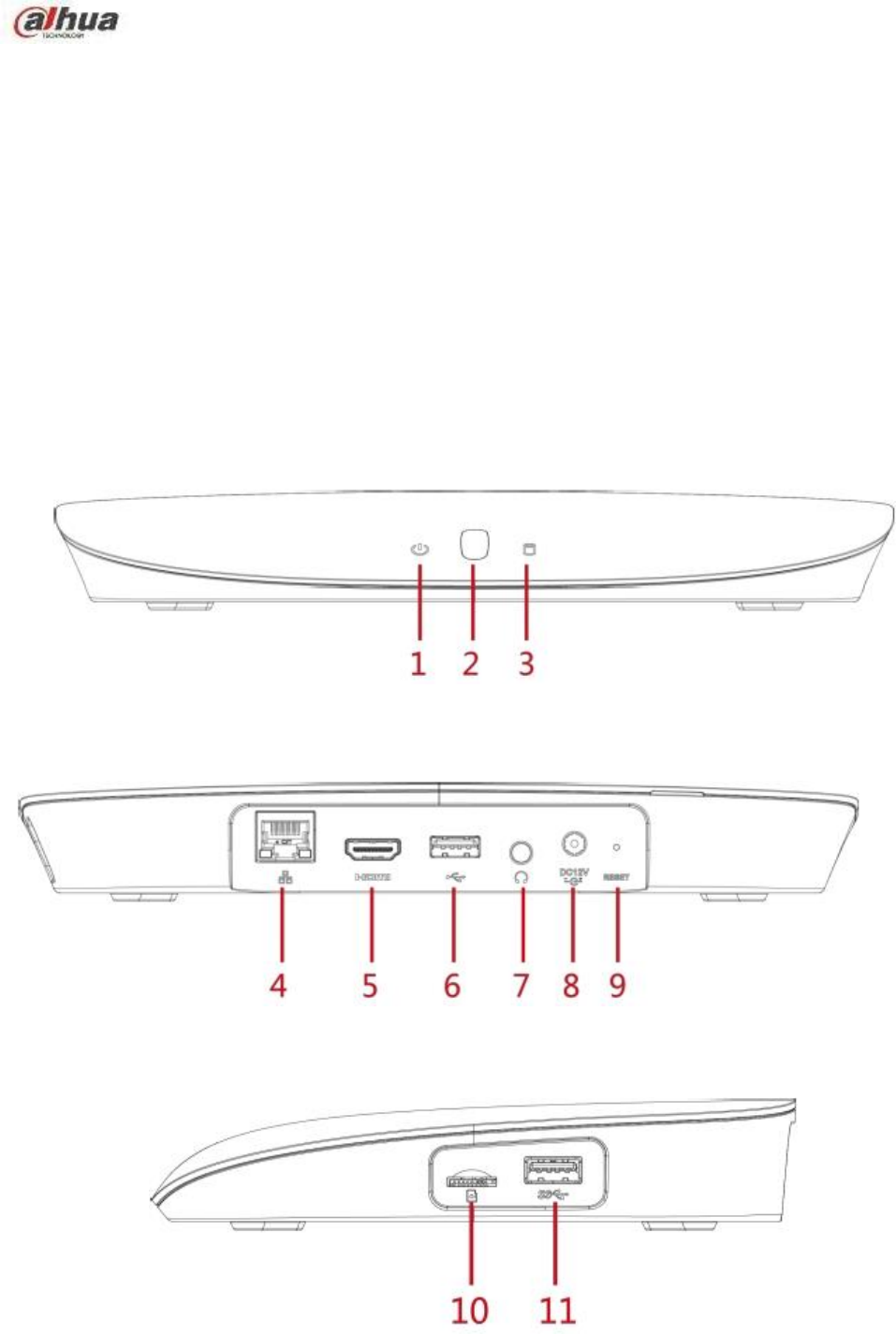
1 General Introduction
1.1 Overview
NAS (network attached storage) is a private network storage device for private data backup, sharing and
storage.
NAS provides the storage function (unit: TB) based on the Android OS. It supports 4K HDMI video output,
HIFI (High-Fidelity) audio output. It supports cell phone APP remote management and data access, view,
and downloads the record file and image remotely.
After connected NAS to the network camera, it supports real-time preview, record playback, alarm event
push and etc. It can provide total solutions for home security.
1.2 Front Panel/Rear Panel/Side Panel
The front panel is shown as in Figure 1-1.
Figure 1-1
The front panel is shown as in Figure 1-2.
Figure 1-2
The front panel is shown as below. See Figure 1-3.
Figure 1-3
4

SN
Indicator
Light/Port
Function
1
Power
indicator light
Power indicator light.
The light is off if it has not connected to the power sourcing.
The orange light is on during the system boot up process or press
RESET button for a long time to reset the system.
The white light is on when system is working properly after
initialization.
2
Signal
inductor
It is to receive the IR signal from the remote control.
3
HDD indicator
light
HDD status indicator light.
The light is off when there is no HDD or system cannot detect the
HDD.
The orange light is on when HDD is error.
The white light is on when HDD is running properly.
4
Network port
100/1000Mbpsself-adaptive Ethernet port. Connect to network cable.
5
HDMI port
High definition audio and video signal output port. It transmits
uncompressed high definition video and multiple-channel data to the
HDMI port of the display device.
6
USB2.0 port
USB2.0 port. Connect to mouse, keyboard, USB device and etc.
7
Audio output
port
Audio output port. It is to output the analog audio signal to the devices
such as the sound box.
8
Power port
Power input port. Input 12V/1.5A power.
9
RESET
Reset button.
Press REST button for 8 seconds. The power indicator light becomes
orange and device automatically begins reboot. Device restores
factory default setup after reboot.
10
SD card port
Micro SD card port. Max 128G storage space.
11
USB3.0 port
USB3.0 port. Connect to mouse, keyboard, USB device and etc.
Name
Quantity
Name
Quantity
NAS device
1
Power adapter
1
IR remote control
1
Network connation
cable
1
7# battery
1
HDMI cable
1
Quick Start Guide
1
-
-
SN
Indicator
Light/Port
Function
1
Power
indicator light
Power indicator light.
The light is off if it has not connected to the power sourcing.
The orange light is on during the system boot up process or press
RESET button for a long time to reset the system.
The white light is on when system is working properly after
initialization.
2
Signal
inductor
It is to receive the IR signal from the remote control.
3
HDD indicator
light
HDD status indicator light.
The light is off when there is no HDD or system cannot detect the
HDD.
The orange light is on when HDD is error.
The white light is on when HDD is running properly.
4
Network port
100/1000Mbpsself-adaptive Ethernet port. Connect to network cable.
Please refer to the following table for detailed information.
1.3 Packing List
Please check the accessories according to the packing list.
1.4 Open the Box to Check
Refer to the following table to check the device. Contact the local retailer or our service engineer if there
is any problem.
5

SN
Name
Contents
1
Whole
package
Appearance
There is any visible damage or not.
Package
There is any accidental clash during
transportation or not.
Accessories
Check all accessories are included in
the bag or not.
2
Front
panel and
rear
panel
The model on the front
panel
Check the model with the purchase
order.
The label on the rear
panel.
It is neat and clean or not.
Note
Do not tear off, or discard the label.
Usually we need you to represent the
serial number when we provide the
service after sales.
3
Case
Appearance
There is any visible damage or not.
Check the data cable,
power cable, fan cable,
main board and etc.
Check the connection is secure or not.
Note
Contact your local retailer or our service
engineer if the connection is loosened.
6
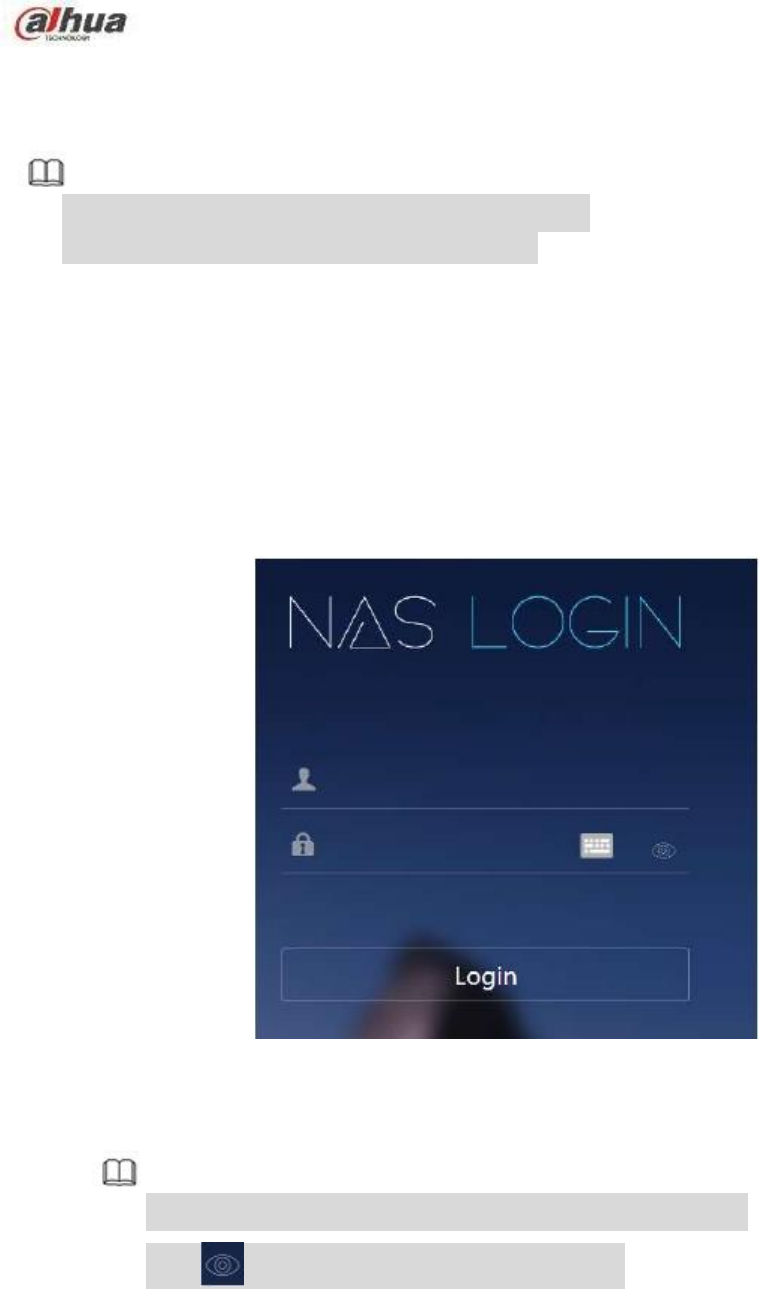
2 WEB
Use PC (personal computer) to access the device WEB to manage it.
Note
Check the PC and device connection before login the WEB.
Right now the browser supports Chrome and FireFox.
2.1 Login
Use browser to access the device WEB, it is to access and manage the device remotely.
Steps:
Step 1
Step 2
Step 3
Open browser and input the device IP address in the address column.
Click Enter button.
Enter WEB login interface. See Figure 2-1.
Figure 2-1
Enter user name and password.
Note
The device default user name is admin and the password is admin.
Click
to display the input password contents.
Step 4 Click Login.
Enter main interface. See Figure 2-2.
7
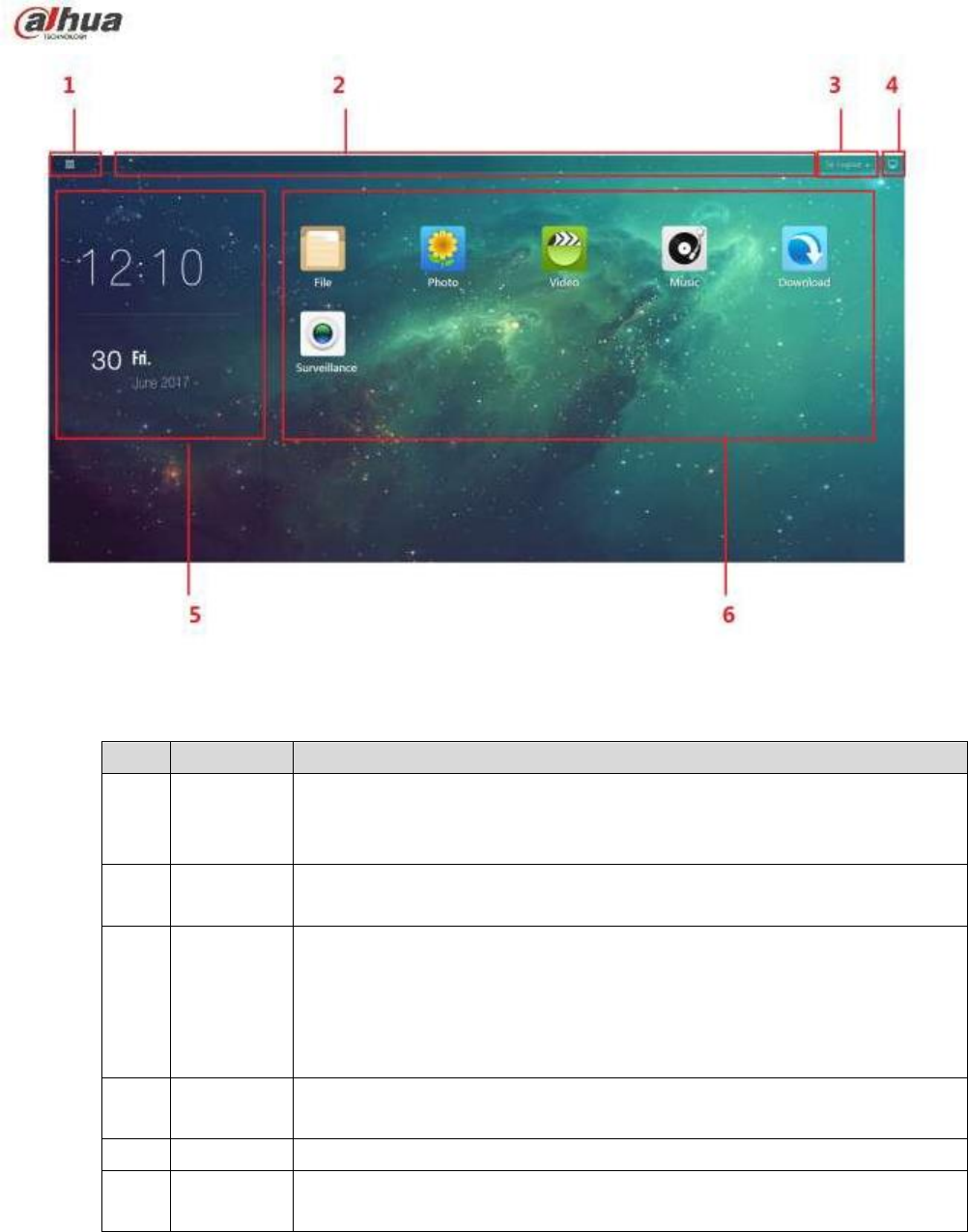
SN
Name
Function
1
Main menu
Click , enter main menu interface. See Figure 2-3. It is to view
system applications and installed applications.
2
Task bar
It is to display current running APP icon. Right click APP icon to restore,
maximize, minimize, close the APP.
3
Logout
Click to logout current user.
Click to select reboot or shut down. It is to reboot or shut down
the device.
4
Home
Click to display main interface.
5
Time pane
It is to display system current time and date.
6
Function
pane
It is to display current installed APP.
Figure 2-2
Please refer to the following table for detailed information.
8
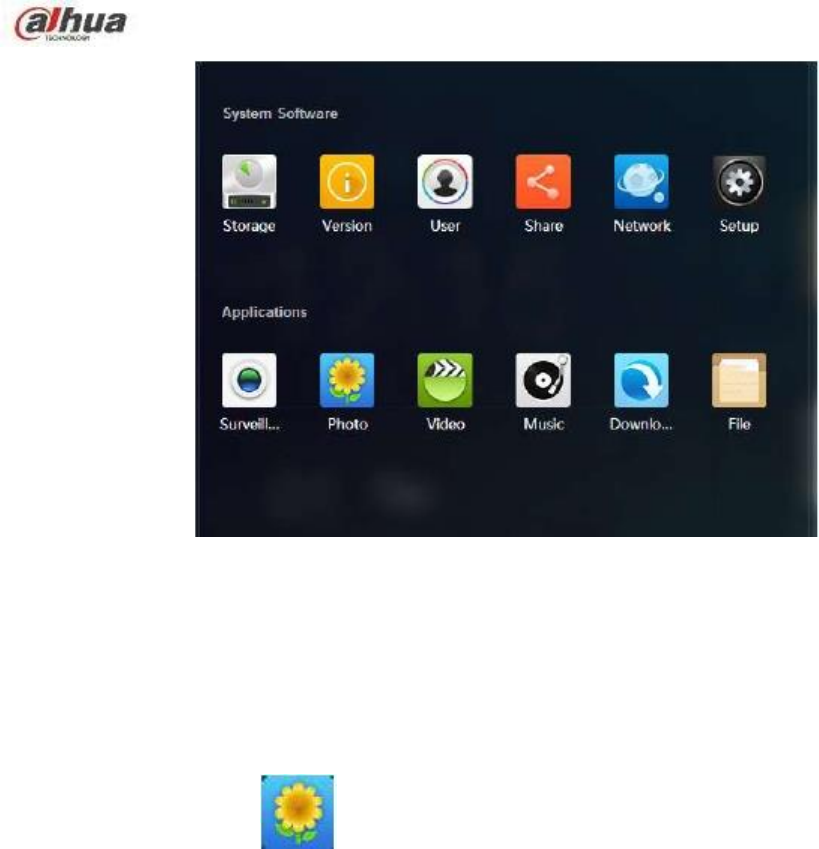
Figure 2-3
2.2 Photo
It is to upload the photo to the device to storage and use the photo applications to play online.
Steps:
In the main interface, click
, enter photo interface. See Figure 2-4.
Right click Photo or click any photo in the list, it is to create a new photo or delete an old one.
Select an album and then click Upload, or select photo(s) and then click open, it is to upload the
image(s) on the local PC to the corresponding album.
Select an album and then click Play slide, system play all images from the album in full-screen. Click
any position in the image; it switches to the next image. Click ESC to exit full screen.
Right click any image, it can view, add to the favorites, delete.
9
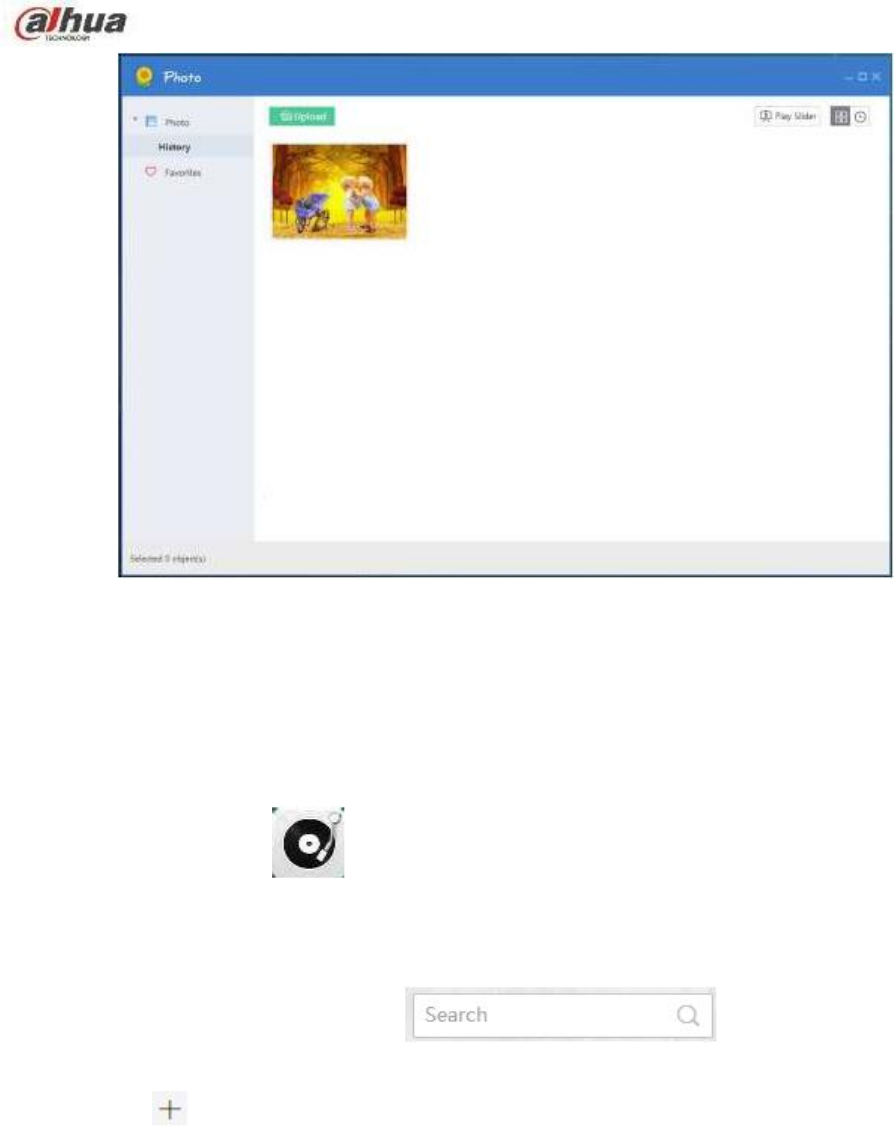
Figure 2-4
2.3 Music
It is to upload the video to the device to storage and use the player to play online. \
Steps:
On the main interface, click
, enter music interface. See Figure 2-5.
Click Play all, device plays all songs in current list.
Click Add song, and then select a music file to upload, click Open, it is to upload the local PC music
file to the corresponding list.
Input the search key words in
corresponding search results.
, device can display the
Click the
on the right of the playlist, it is to create a new playlist.
The music play control pane is at the bottom of the interface.
10
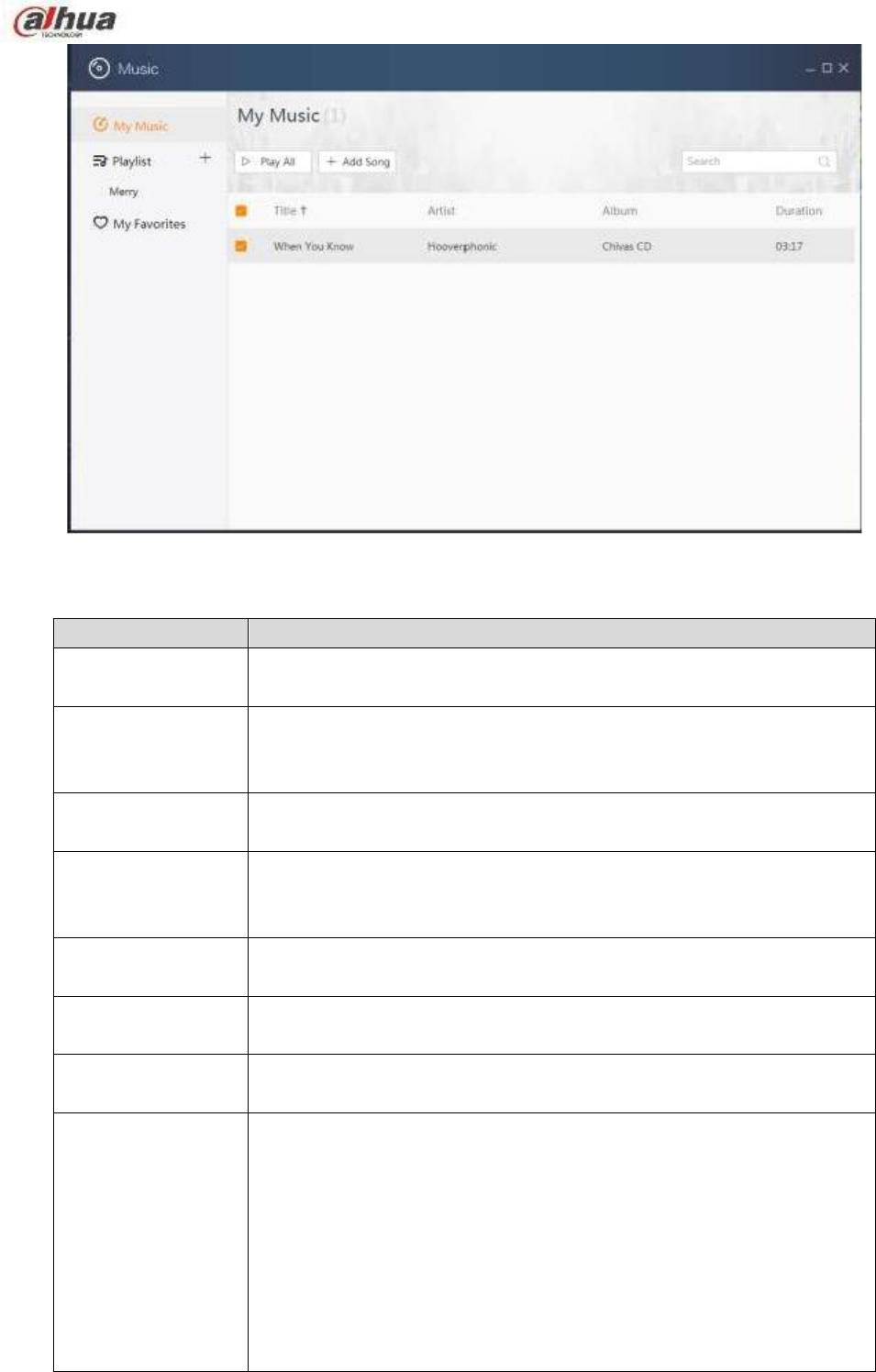
Icon
Function
Click to play the previous song.
Select a song in the list and then click the icon to play. Now the icon
becomes ,click to pause paly.
Click to switch to the next song.
Click to change to lyric mode, it is to view the lyric. Click the icon again
to go back to the list mode.
Display current music play process, play time and total period.
Click to add current music to the My favorites.
Click to adjust volume.
Click to select music play mode.
=Repeat play list.
=Randon play.
=Sequenc play.
=Repeat current song.
Figure 2-5
Please refer to the following table for detailed information.
11
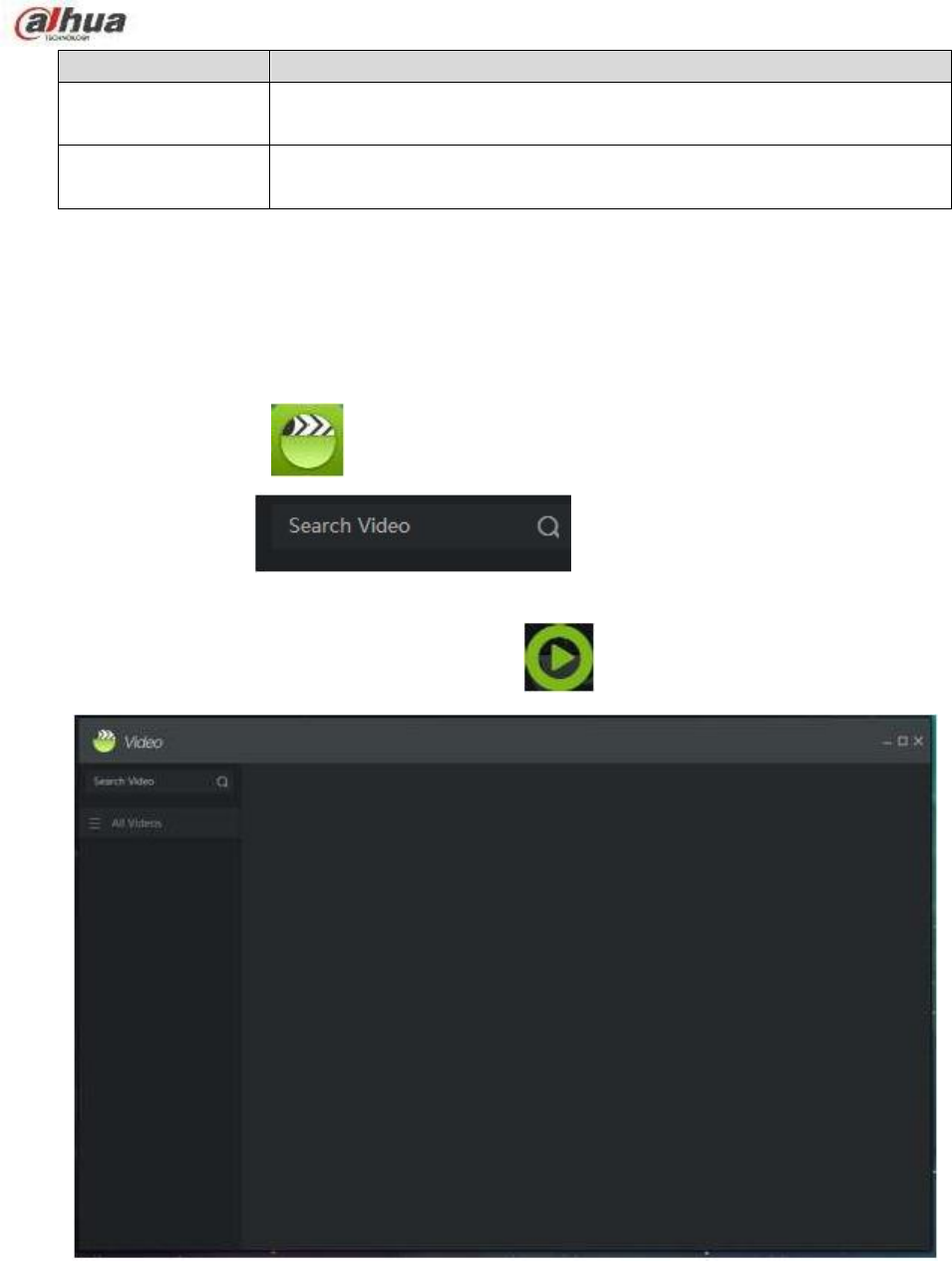
Icon
Function
Click to view current play music list. Click Clear to clear play list.
Display current played music amount. Click to view the played music
list.
2.4 Video
Upload the video file to the device to storage and use player to play online.
Steps:
In the main interface, click
, enter audio/video interface. See Figure 2-6.
Input key words in
corresponding search results.
Move the mouse to the video file, device pops up
and click Enter button, device displays the
. Click the icon, it is to play the video file.
Figure 2-6
2.5 File
It is to view the data file storage on the device.
12
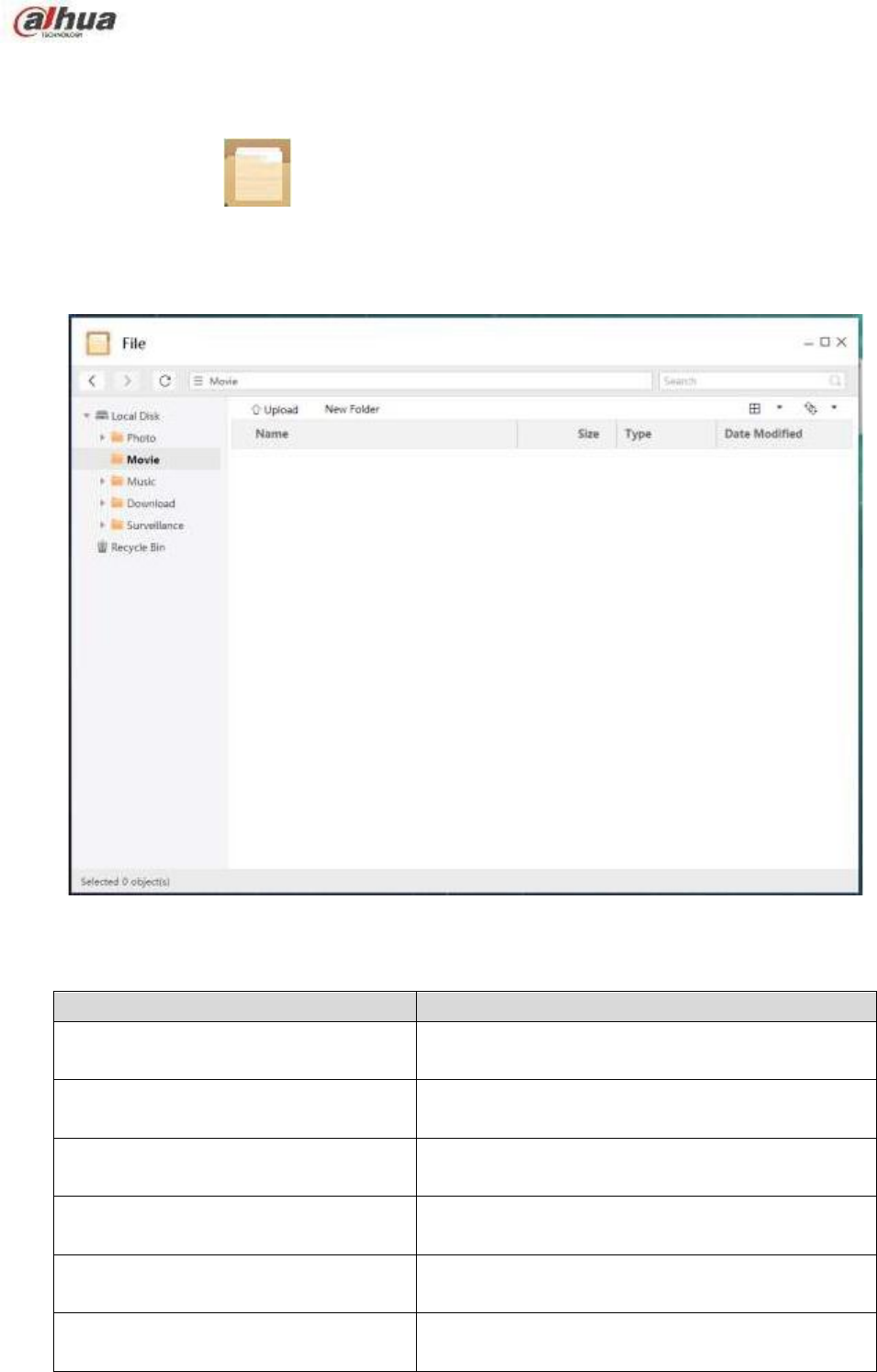
Icon
Function
Click to go back to the previous path.
Click to cancel go back to the previous path
Click to refresh file list.
Input search key words, device displays
corresponding file list.
Click to select file(s) to be uploaded, click Open to
upload local PC to the device.
Click to add a new folder.
Steps:
In the main menu, click
, enter file interface. See Figure 2-7.
Right click the file name in the file list on the right pane, it is to download, copy/paste/cut, delete,
rename the file, or view the file properties.
Right click file, click download, it is to download the file to the local PC.
Figure 2-7
Please refer to the following table for detailed information.
13
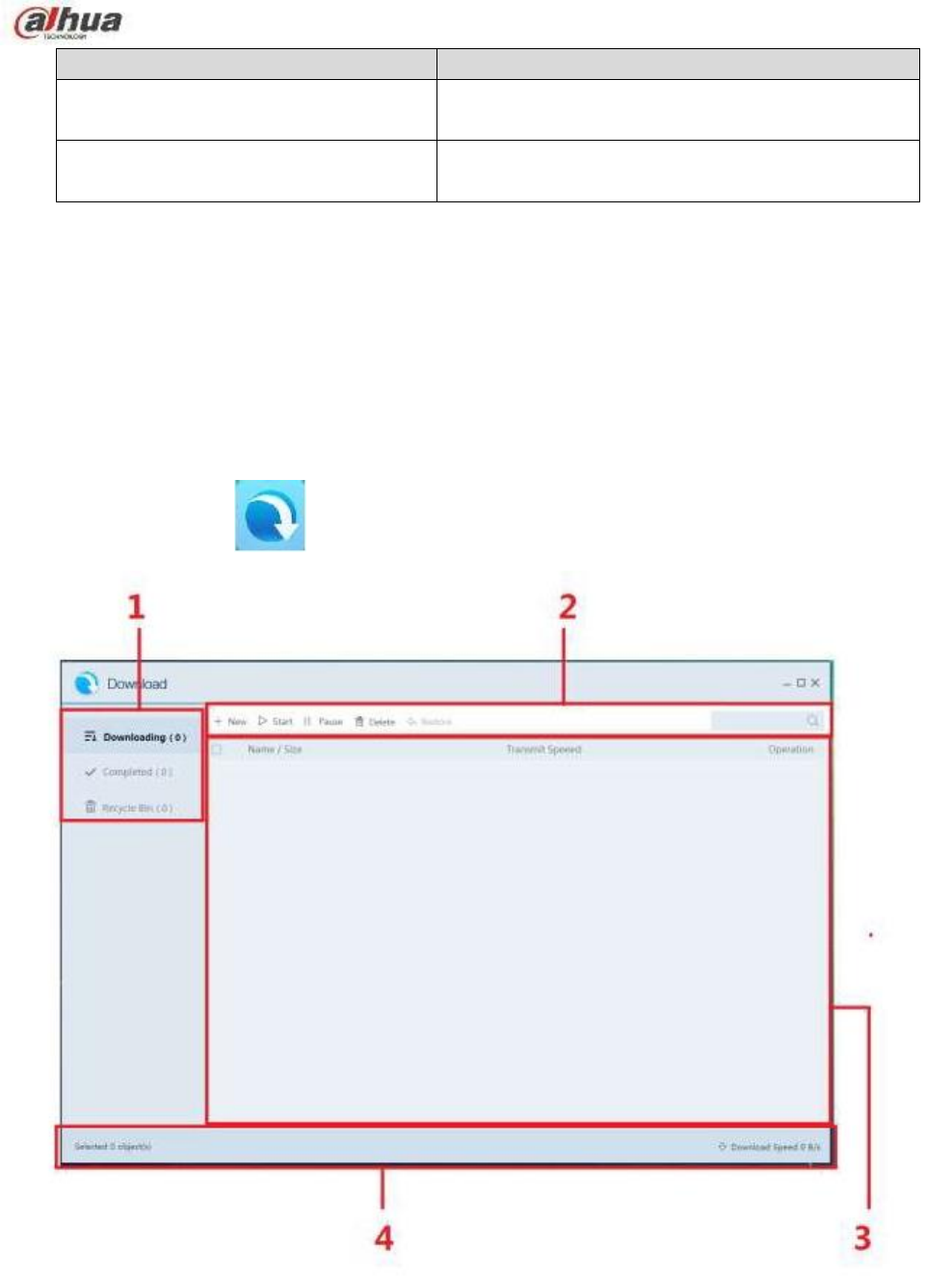
Icon
Function
Click to select file display mode. It includes list,
small icon, medium icon and large icon.
Click to select file sequence. It includes name, size,
type and time modified.
2.6 Download
System supports BT(BitTorrent), magnet-uri ,HTTP/HTTPS, FTP/FTPS to download file. It max supports
5 download tasks at the same time.
Refer to appendix for Download Mode for BT(BitTorrent), magnet-uri ,HTTP/HTTPS, FTP/FTPS detailed
information.
Steps:
In the main menu, click
to enter download interface. See Figure 2-8.
Figure 2-8
Please refer to the following table for detailed information.
14

SN
Function
1
Download catalog bar.
Downloading: Display downloading, pause, to be downloaded or error task
information.
Finished: Display finished task information.
Recycle: The deleted task information from the downloading list or the finished
list.
2
Task operation bar
Click to add new download task. Refer to chapter 2.6.1 New task for
detailed information.
Pause task in the downloading list, click the icon or right click mouse
and then select start to resume download process.
Select a download task in the downloading list and then click the
icon or right click mouse to pause current task.
Delete download task. Refer to chapter 2.6.2 Delete task for
detailed information.
In the recycle select the deleted download task, and then click
the icon or right click mouse to restore the task.
Input the search key words, system displays the
corresponding results.
3
Download main window. It is to display download task detailed information.
Name/size: Display download file name, size.
Transmit Speed: Display download speed and remaining time. If the download
failed, system pops up failed to download dialogue box. The download process
bar is grey.
Operation: Click to begin download, click to pause download.
4
View download state. Display current selected task amount and download total
speed.
2.6.1 New Task
System downloads new task by default after you created it. The state is downloading. If current download
tasks have exceeded 5 (system max download threshold), the new task state is to be downloaded.
Steps:
Step 1
In the main interface, click
.
15
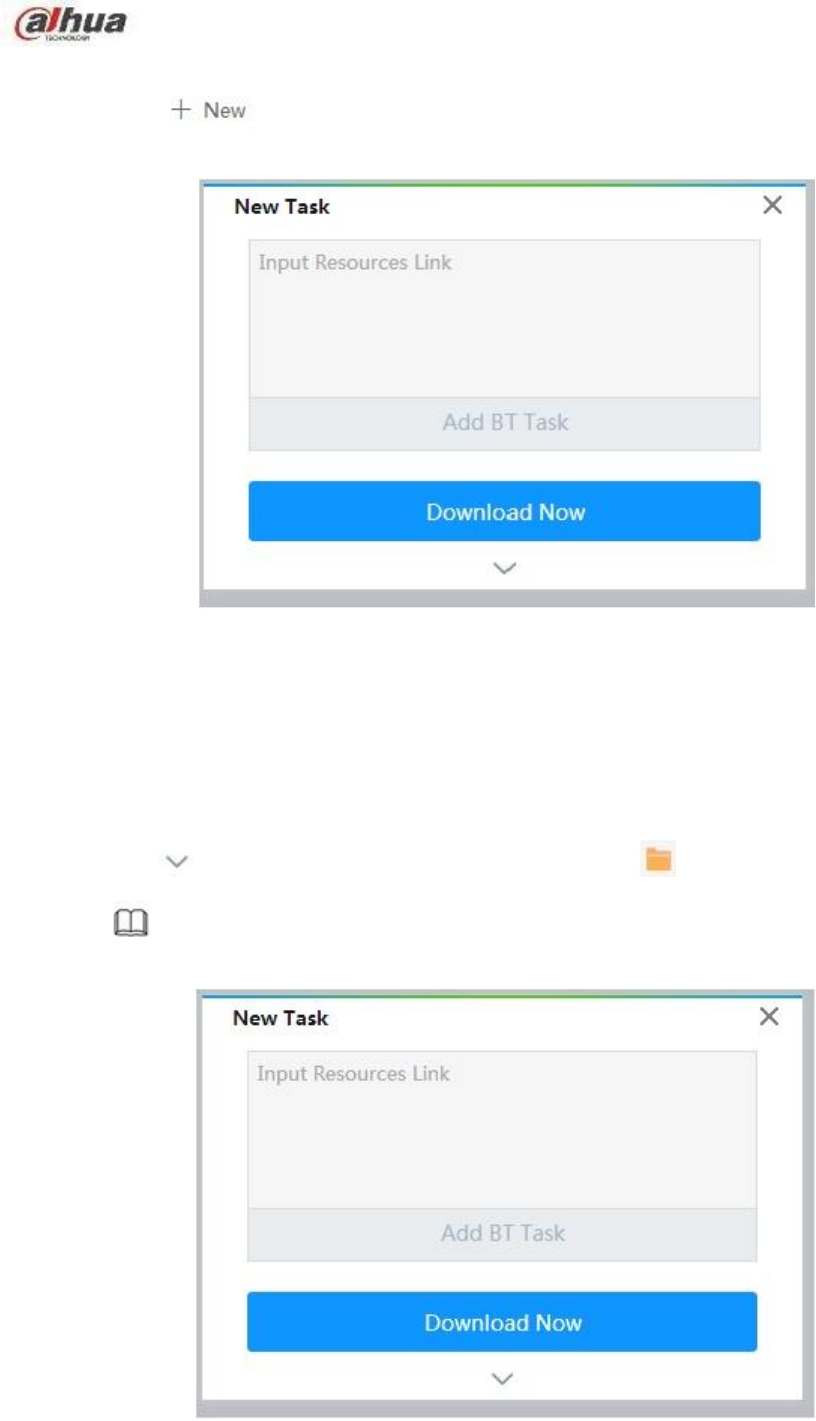
Enter download interface. See Figure 2-9.
Step 2
Click
.
Enter Add task interface.
Figure 2-9
Step 3
Input download link or add BT file.
BT download: Add BT task and select corresponding .torrent file.
Other download: Input download path. Different download modes have different download
links. Please refer to the actual situation to set.
Step 4 Select save path.
Click
to select path interface. See Figure 2-10. Click
to select saved path.
Note
System save file to the previous path by default if you do not set new path here.
Figure 2-10
16
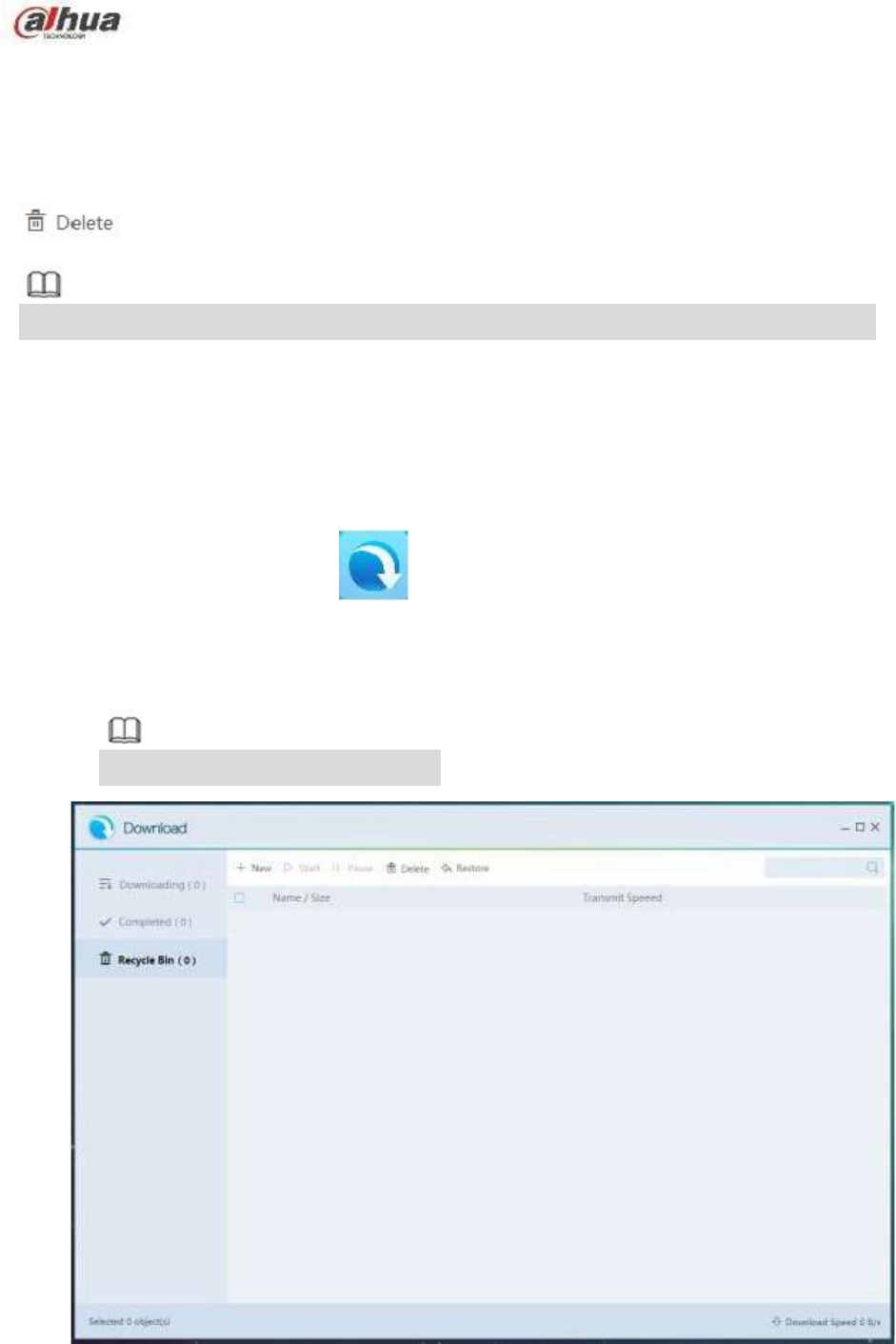
Step 5
Click Download Now.
Enter downloading list to view new task state and download process.
2.6.2 Delete Task
Select a task in the list (download task, finished task or the task deleted in the recycle) and then click
, or right click mouse and then select delete, enter delete interface.
Note
Check the box to select delete download file, system can delete the downloaded file at the same time.
2.6.3 Restore Task
Go to the recycle to restore the download task.
Steps:
Step 1
In the main interface, click
.
Enter download interface. See Figure 2-8.
Step 2 Click Recycle bin.
Enter recycle interface. See Figure 2-11.
Note
The speed here displays deleting speed.
Figure 2-11
17
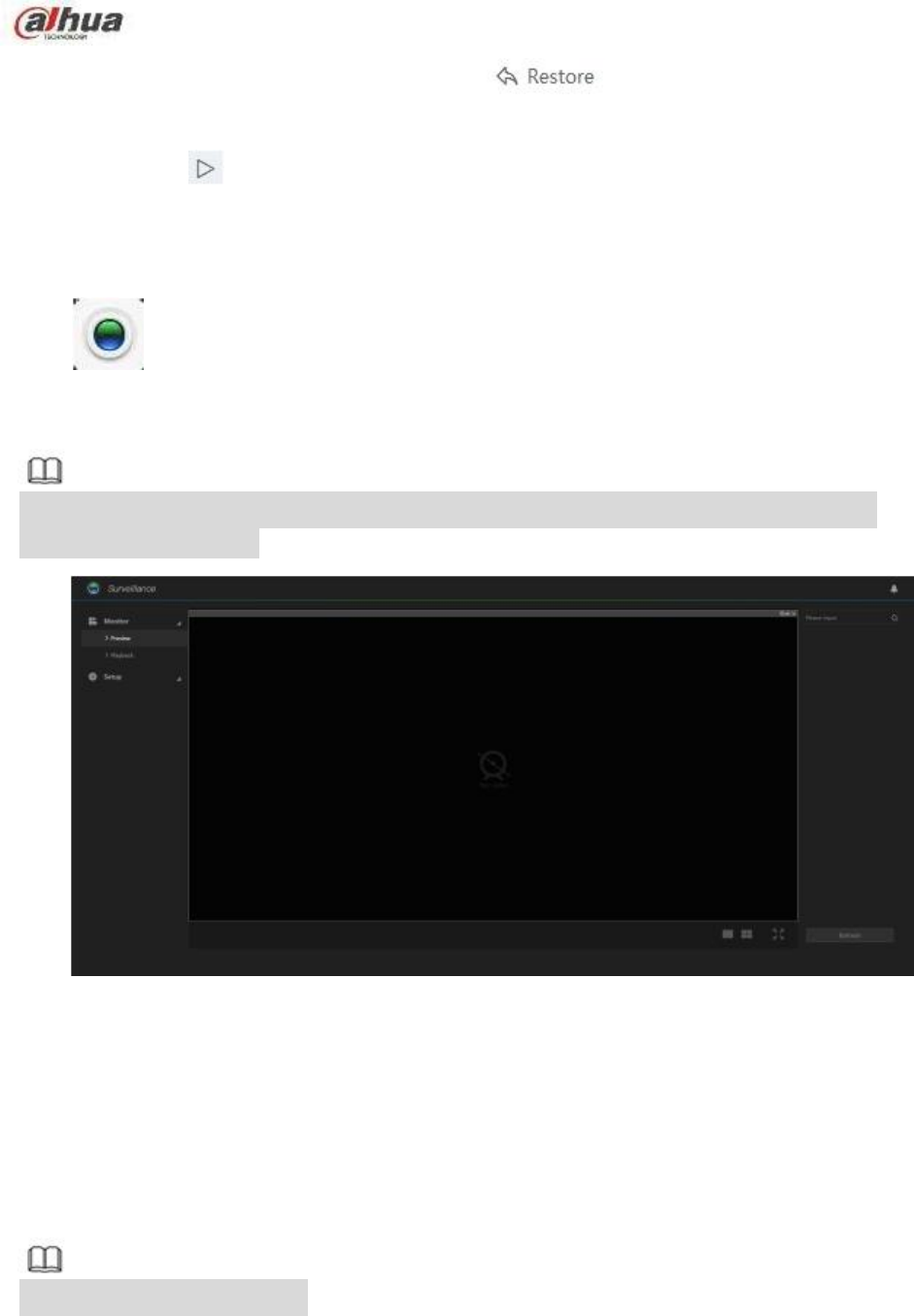
Step 3
Select a task to be restored and then click
,
System restore the task. Go to the downloading interface to view the download task.
Step 4
Click the
of the corresponding download task.
System begins downloading task again.
2.7 Surveillance
Click
, enter preview and monitor interface. See Figure 2-12.
Connect to the camera, system can display real-time monitor video, playback record file, set camera
parameters remotely.
Note
If it is your first time to enter the preview interface, the window prompts you to install plugins. Please
follow the prompts to install.
Figure 2-12
2.7.1 Initialization Settings
The initialization settings include add remote device and enable remote device record function.
2.7.1.1 Register Camera
It is to manage camera such as add, edit, upgrade camera and etc. It supports to change channel name,
bit rate parameters and etc.
Note
System max supports 4 cameras.
Steps:
There are many ways to register the camera such as search and then add, add by IP address, batch add,
18
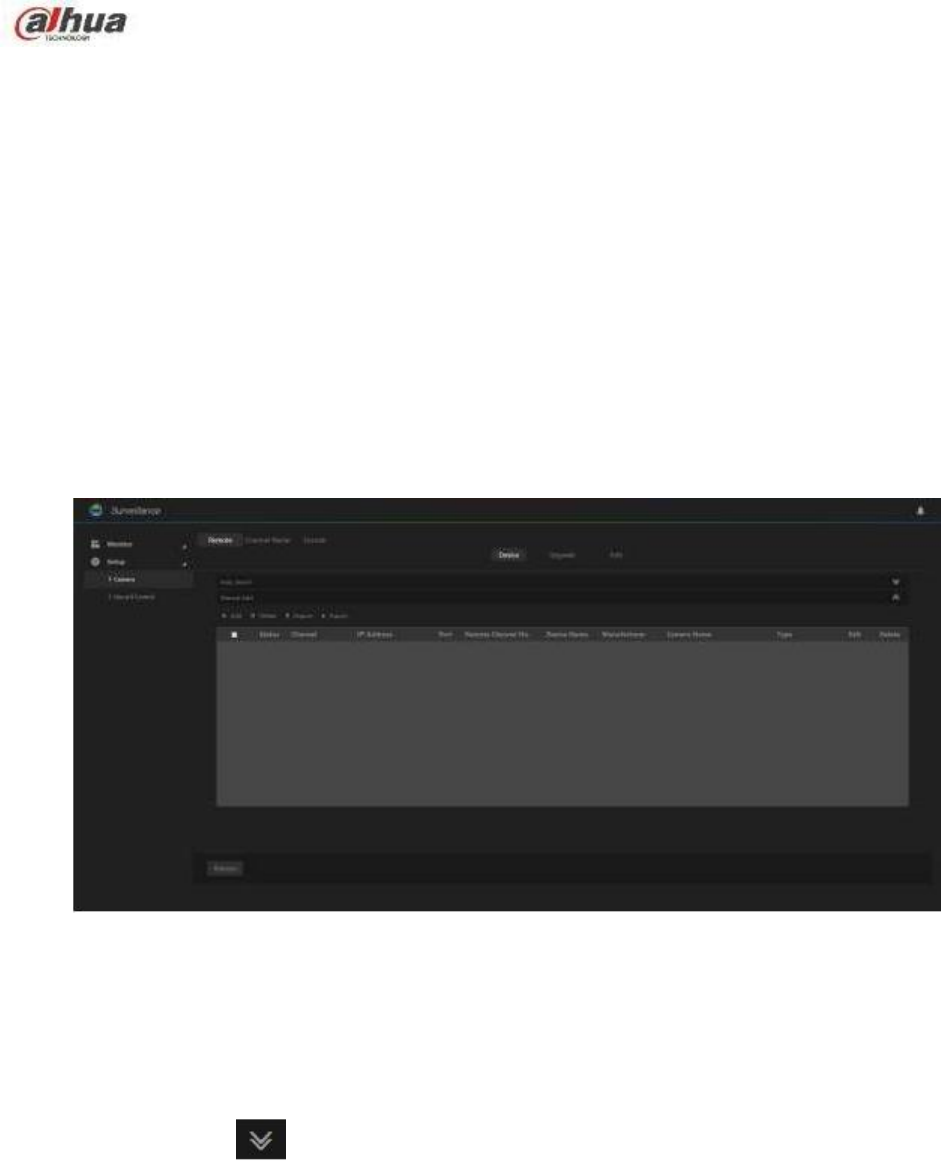
using template to add. Here we introduce search and then add function.
Search and then add: Search to find the remote device and then add. This function is useful if you do
not know the remote device IP address.
Add by IP address: Add remote device by IP address. This function is useful if you know the remote
device IP address, user name and password.
Batch add: Add several remote cameras by the same time. Please make sure these remote devices
are in the same IP segment such as (192.168.1.1~192.168.1.255), and the user name and
password are the same. It can greatly enhance add efficiency.
Import by template: Add remote device by import template.
Steps:
Step 1
Step 2
On the surveillance interface, from Setup->Camera->Remote->Device.
Enter Device interface. See Figure 2-13.
Figure 2-13
Register camera.
There are four ways: search and then add, input IP address and then add, batch add and use
template to add.
Search and then add
1.
Click the
on the right side of the Auto search.
Enter auto search interface. See Figure 2-14.
19
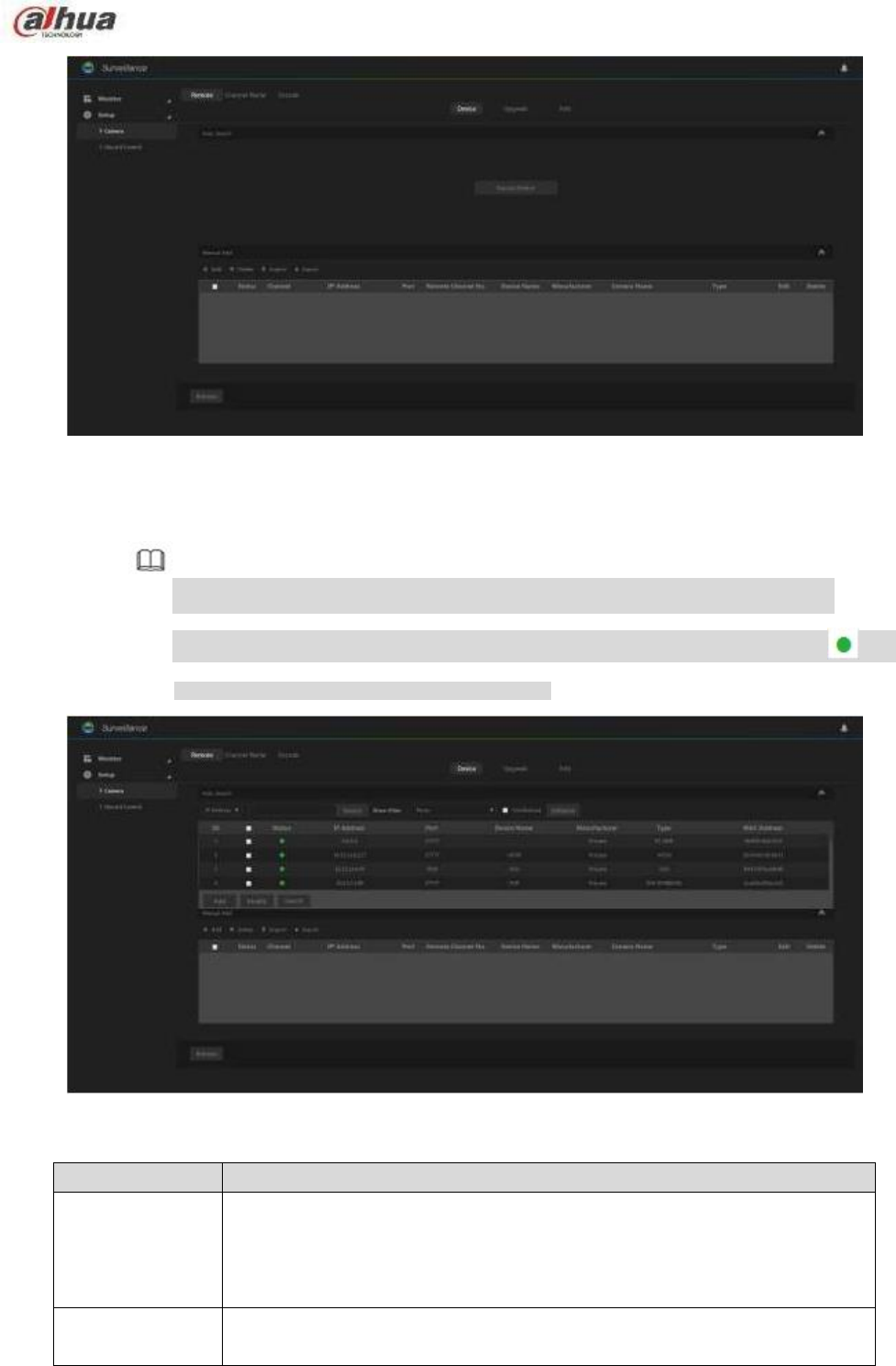
Icon/Item
Function
Filter the remote device via the IP address or the MAC address.
Select IP address or the MAC address from the dropdown list and then
input the corresponding information, click Search button to view the
results.
Display filter
Set filter criteria according to device type. Device only display the devices
matching the criteria. It is suitable for the user to find the desired device(s).
Figure 2-14
2. Click Found device.
Enter search results interface.
Note
The remote device on the added list will not be displayed on the searched results.
State column is to display current remote device has been initialized or not.
means it has been initialized. See Figure 2-15.
Figure 2-15
Please refer to the following table for detailed information.
20
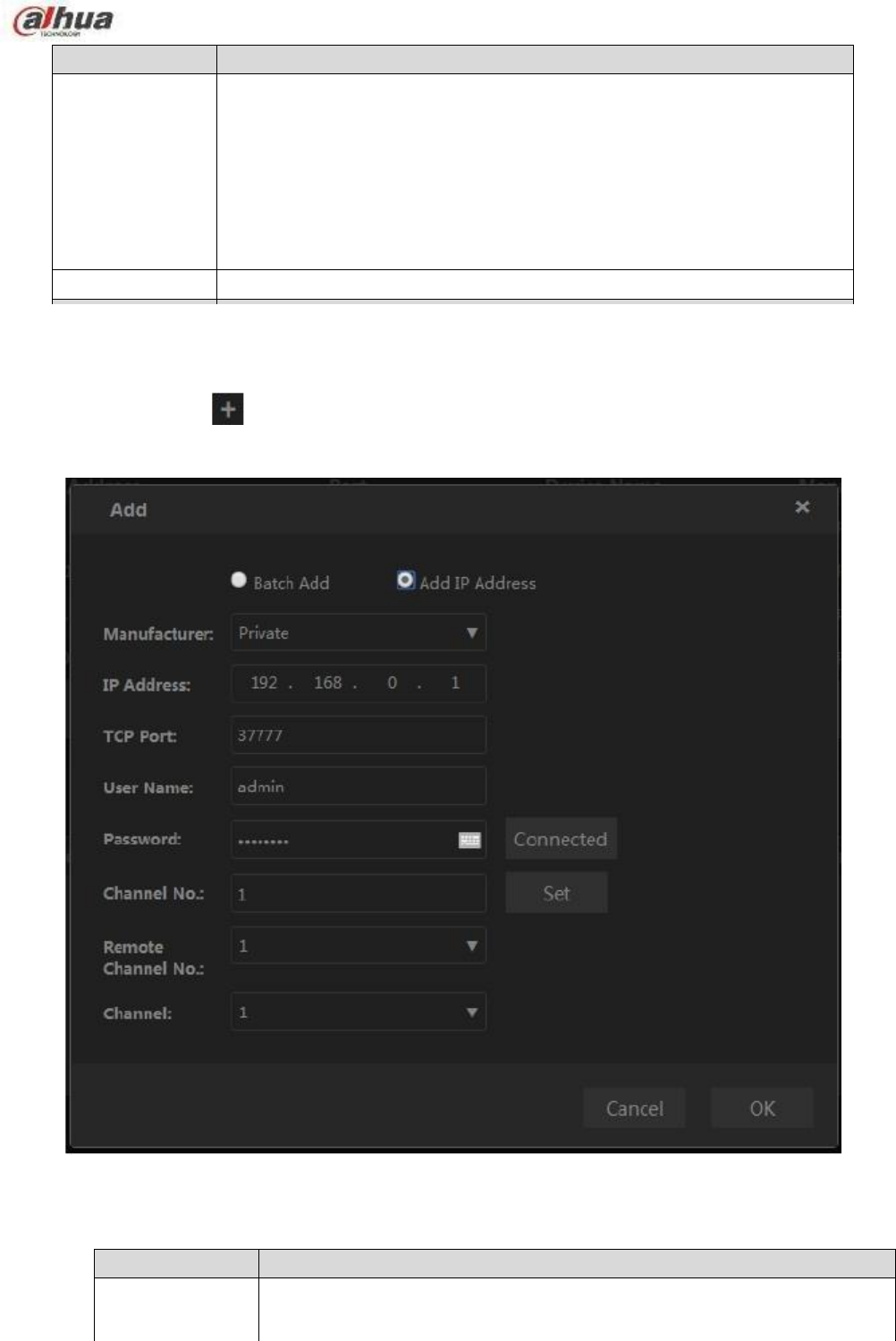
Icon/Item
Function
Modify
Check a device and then click the Modify button to change the remote
device IP address.
Note
Make sure the remote device is network camera and the manufacturer
is private. Otherwise this function is null.
Change remote device IP address one by one.
Search
Click to search remote device again.
Name
Function
Manufacturer
Select manufacturer protocol from the dropdown list.
IP address
Set remote device IP address.
Icon/Item
Function
Modify
Check a device and then click the Modify button to change the remote
device IP address.
Note
Make sure the remote device is network camera and the manufacturer
is private. Otherwise this function is null.
Change remote device IP address one by one.
3.
Double click remote device or check the remote device and then click Add.
The selected remote device is added to the device list.
Input IP address and then add
1.
Input the
on the manual search, select add by IP address.
Enter add interface. See Figure 2-16.
Figure 2-16
2.
Set parameters.
21

Name
Function
TCP port
TCP port value. Default setup is 37777. Input the actual port number if
necessary.
Note
Set TCP port value when manufacturer protocol is private.
RTSP port
RTSP port value. Default setup is 554. Input the actual port number if
necessary.
Note
Do not need to set RTSP port value when manufacturer protocol is private
or customized.
HTTP port
Set the HTTP port value of the remote device. The default setup is 80.
Note
Do not need to set HTTP port value when manufacturer protocol is private
or customized.
User
name/password
The user name and password to login the remote device.
Channel amount
Input channel amount or click Connect to get the remote device channel
amount.
Note
Recommend you click the Connect button to get the remote device
channel amount. If the input channel amount is not right, system cannot
add remote device.
Remote channel
number.
After getting remote device channel amount, click Set to select a channel
to connect.
Channel
The channel to connect to the remote device.
Service type
Set the service type of the remote device.
Note
The supported service type may vary if the device manufacturers are
not the same. Refer to the actual interface for detailed information.
The default connection mode is TCP if the remote device is using the
private protocol.
3.
Click OK to add.
Batch Add
1.
Click the
on the manual search pane, select batch add.
Enter add interface. See Figure 2-17.
22
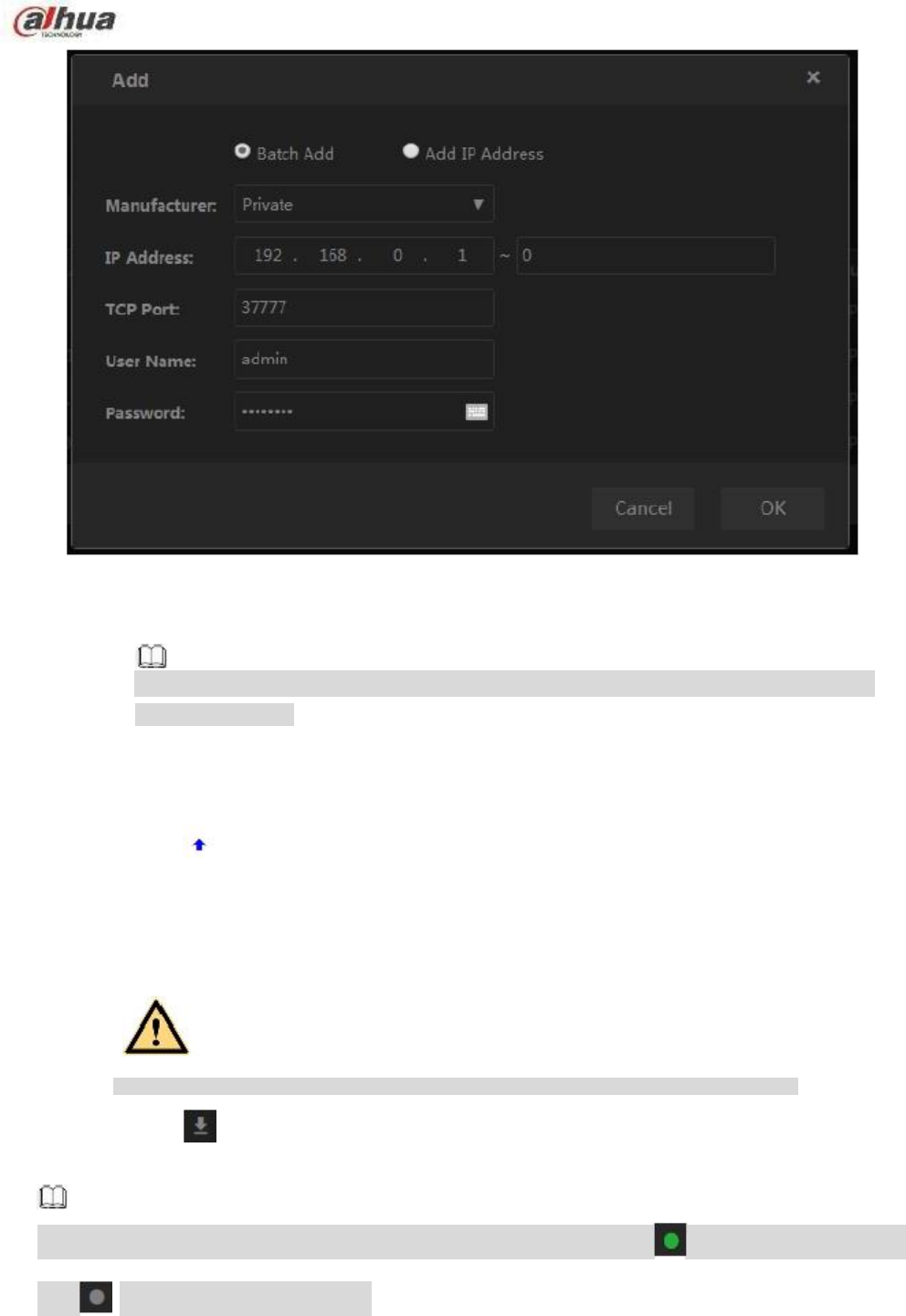
Figure 2-17
2.
3.
4.
Set IP range you want to add.
Note
The batch add is for the remote devices on the same IP segment. Please set the fourth field
of the IP address.
Refer to the above table to set other parameters.
Click OK to complete the add process.
Import template to add
1.
Click
to select save path and click Save to export template.
The exported template file default name is RemoteConfig_2016-12-13.csv.
2016-12-13 refers to the exported date.
The import/export function is for the device of the same language.
2. Input the remote device information and save the template.
WARNING
Do not change template file extension name, otherwise the import operation may fail.
3.
Click
to select template.
4.
Note
Click Open to add the remote device from the template.
After adding the remote device, please check the status column: the
means the connection is
OK.
means the connection is fail.
Edit Remote Device
23
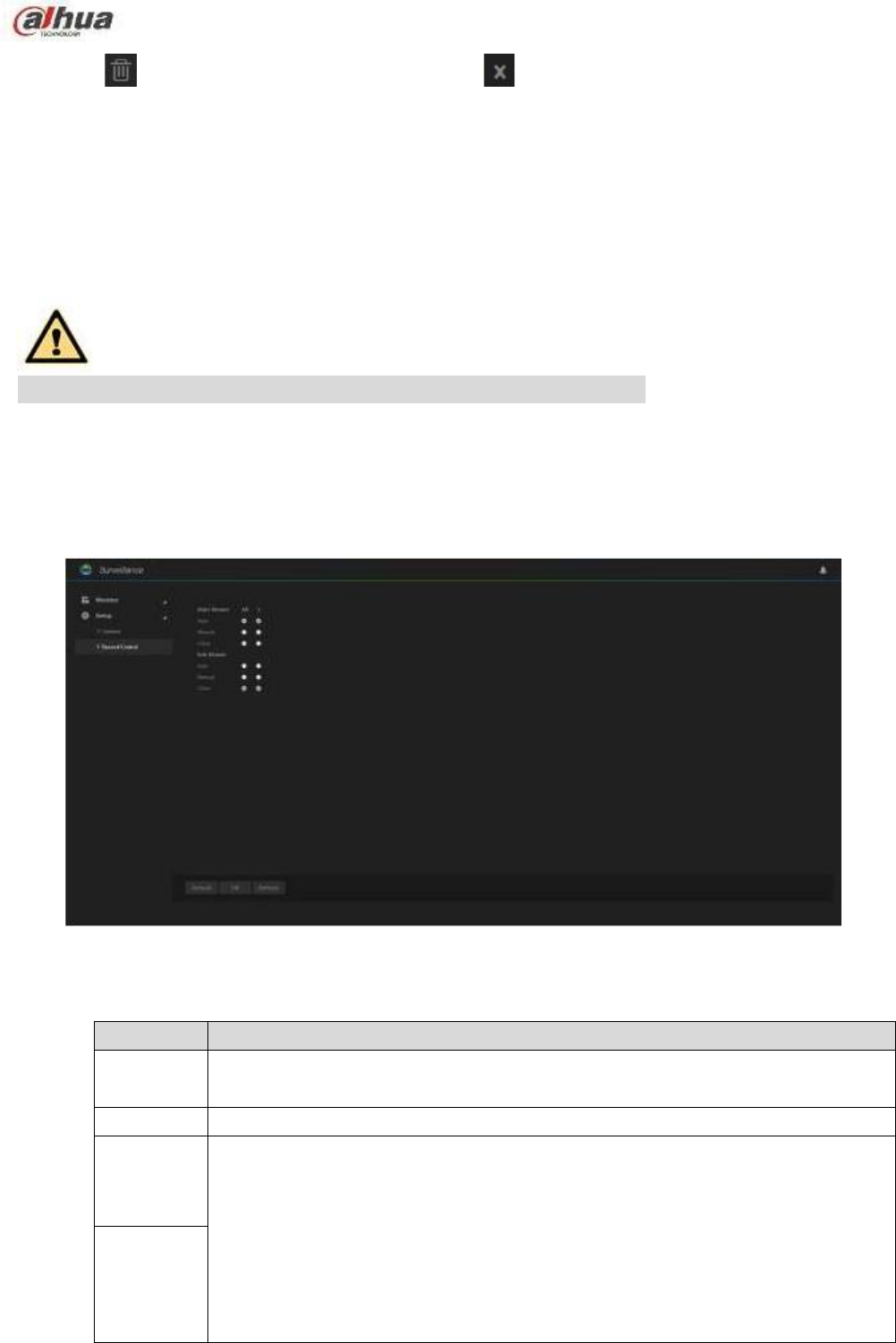
Name
Function
Channel
The server channel that have added the remote device .
Select one or more channel(s). Check All to select all channels.
State
Display current channel status.
Main
stream
Set the record type of the main stream, sub stream. It includes: manual, auto and
close.
Manual: It has the highest priority. No matter channel is in which mode right
now, click manual, the corresponding channel begins general record.
Auto: Automatically record video of the specified record type at the specified
period. It includes motion detect record and general record.
Close:All-channel stops record.
Sub
stream
Click
or select a remote device and then click
to delete a remote device.
Click Refresh to refresh the remote device list.
2.7.1.2 Record Control
The record includes auto record and manual record. After enable auto record function, the remote device
can record at the specified period.
Auto: Automatically record video of the specified record type at the specified period.
Manual: Record for 24H. The record type is regular.
Warning
Please make sure you have storage right before use the manual reord function.
Steps:
Step 1
Step 2
On the surveillance interface, from Setup->Record control.
Enter record control interface. See Figure 2-18.
Figure 2-18
Enable the auto record of the corresponding channel. Set parameters.
24
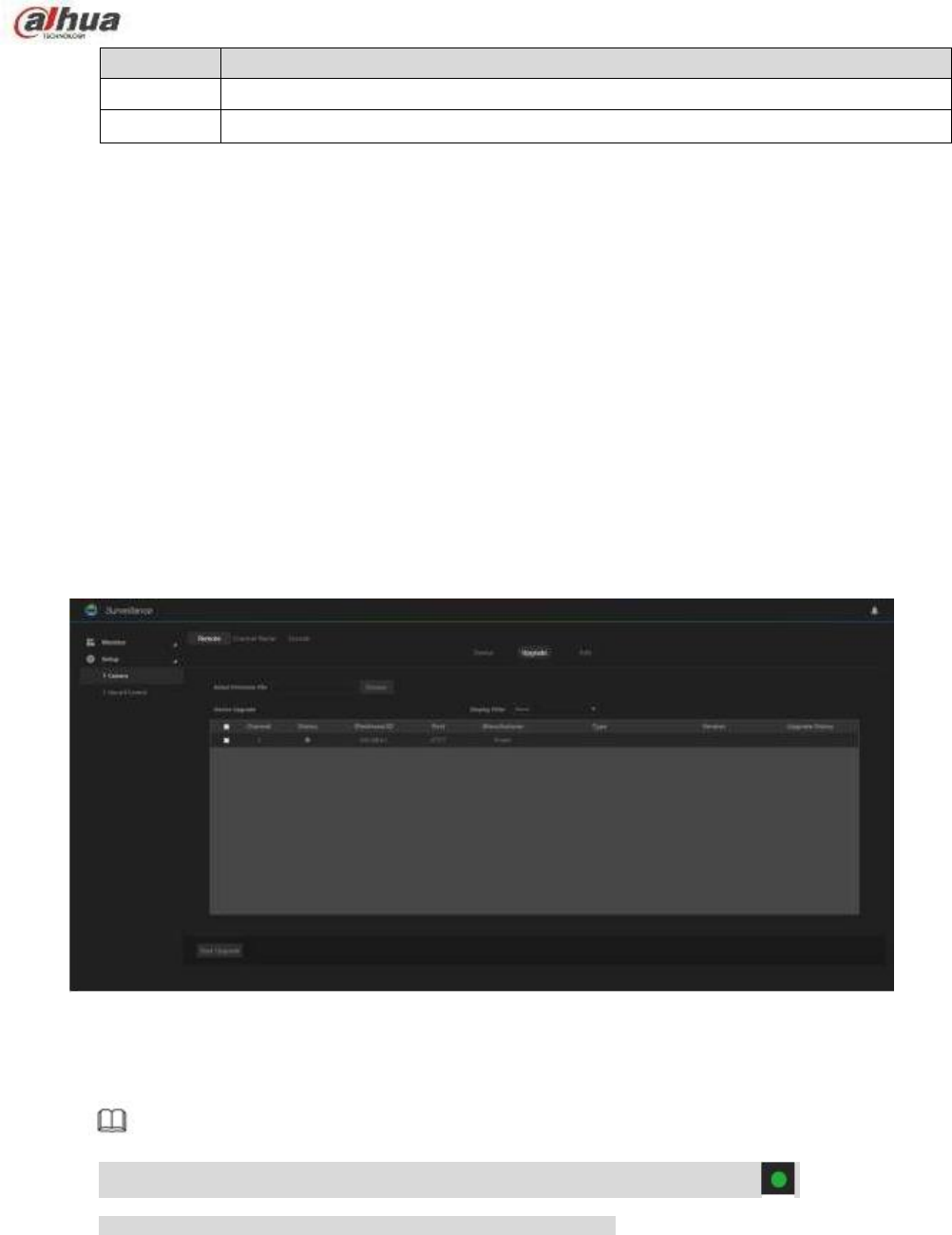
Name
Function
Refresh
Click to get the latest setup information.
Default
Click to restore default setup. Click OK to save.
2.7.2 Remote Device Manager
It is to upgrade remote device, set parameters and etc.
2.7.2.1 Upgrade
System supports upgrade the remote device via the WEB.
Preparation work
Make sure you have gotten corresponding upgrade file.
Steps:
Step 1
Step 2
On the surveillance interface, From Setup->Camera->Remote->Upgrade.
Enter upgrade interface. See Figure 2-19.
Figure 2-19
Select a device to upgrade.
Note
Support private protocol only. The remote device connection status shall be
Use device type to filter if there are too many remote devices.
.
Step 3
Step 4
Click Import to import upgrade file.
Click Start upgrade button.
System begins upgrading the remote device.
2.7.2.2 Info
It is to view remote device information such as channel, IP address, manufacturer, type, applications
25
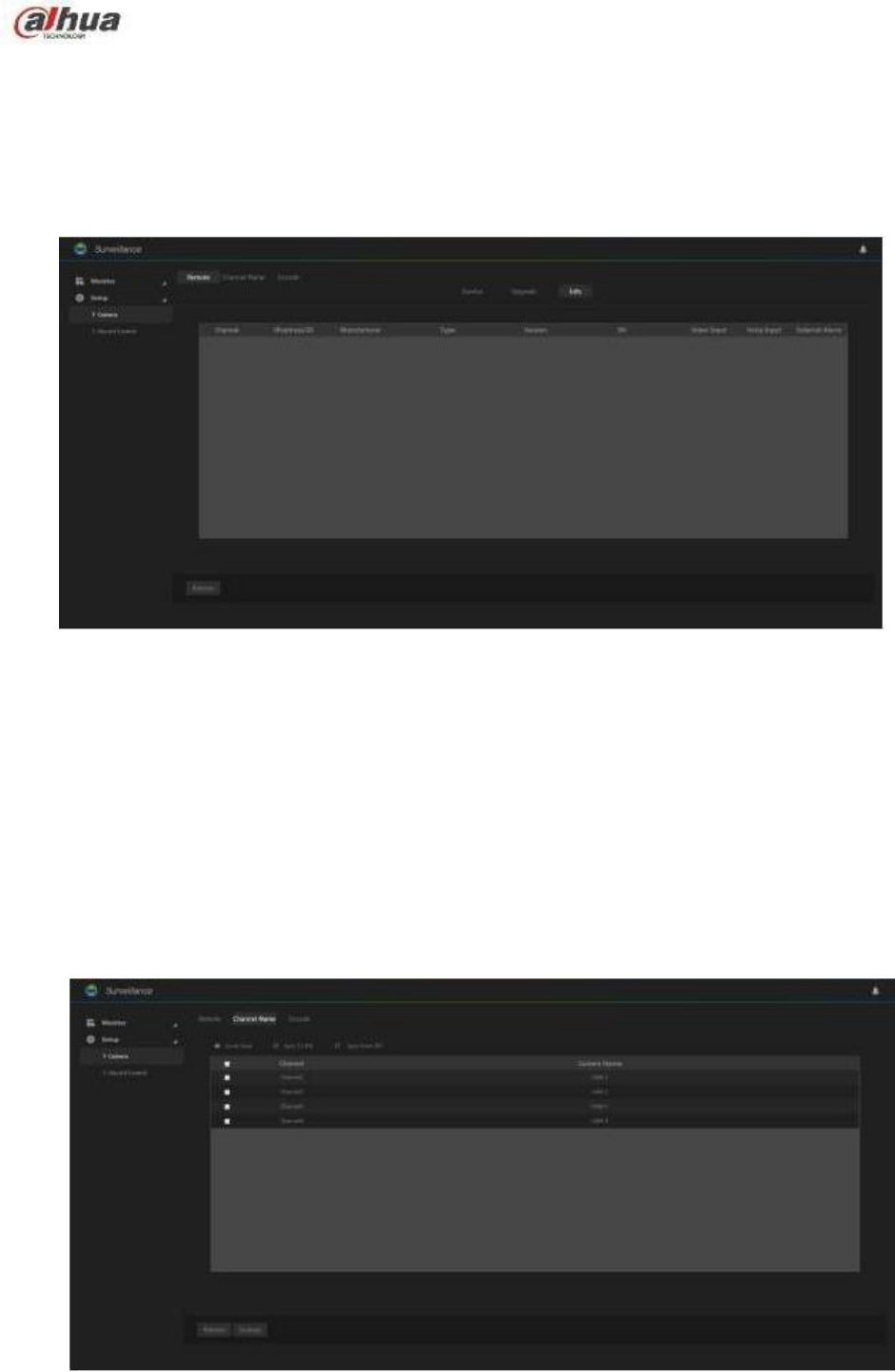
serial number, video input amount, and audio input amount and external alarm amount.
Steps:
On the surveillance interface, from Setup->Camera->Remote->Info, enter info interface. See Figure 2-20.
Click refresh to view the remote device information.
Figure 2-20
2.7.2.3 Channel Name
The server supports customized remote device channel name. It supports local save, sync to IPC, sync
from IPC.
Steps:
On the surveillance interface, from Setup->Camera->Channel name, system displays channel name
interface. See Figure 2-21.
Double click a channel name to edit.
Figure 2-21
26
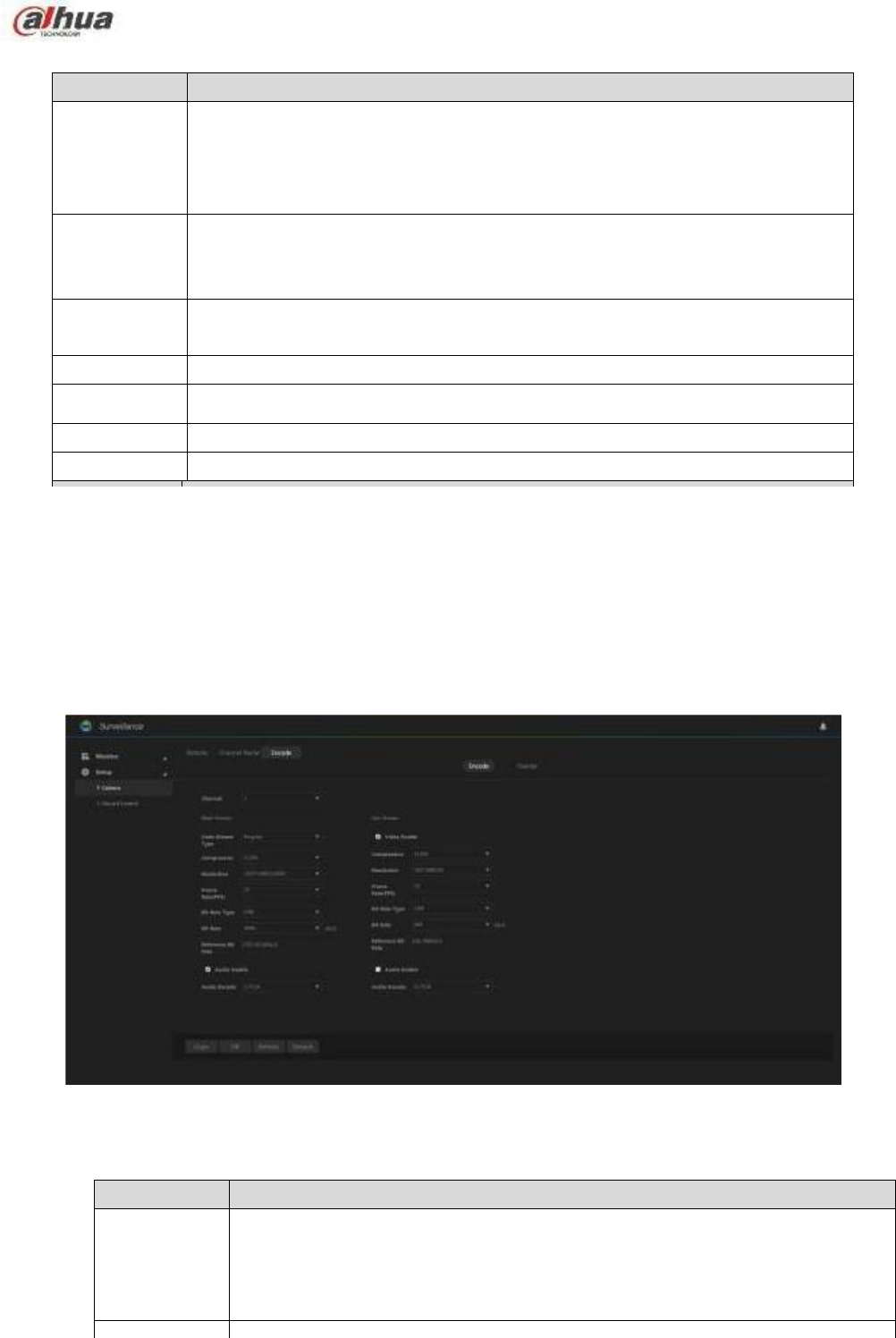
Name
Function
Local Save
After changing a channel name, click , it is to only change the remote
device channel name on the server WEB. The remote device name remains
the same.
Sync to IPC
After changing channel name, click . It is to change the channel name on
the server WEB and the remote device.
Sync from
IPC
Select a channel and then click . It is to get remote device name.
Refresh
Click to get the latest setup information.
Default
Click to restore default setup.
Refresh
Click to get the latest setup information.
Default
Click to restore default setup. Click OK to save.
Name
Function
Channel
Please select a channel from the dropdown list.
Enable video
Check the box to enable sub stream video function.
Code stream
type
It includes general stream, motion stream and alarm stream. The sub stream
supports general bit streams only.
Name
Function
Local Save
After changing a channel name, click , it is to only change the remote
device channel name on the server WEB. The remote device name remains
the same.
Sync to IPC
After changing channel name, click . It is to change the channel name on
the server WEB and the remote device.
Sync from
IPC
Select a channel and then click . It is to get remote device name.
Please refer to the following table for detailed information.
2.7.2.4 Encode
Set the main stream and sub stream of the remote device.
Steps:
Step 1
Step 2
On the surveillance interface, from Setup->Camera->Encode->Encode.
System enters encode interface. See Figure 2-22.
Figure 2-22
Set parameters.
27

Name
Function
Compression
It is to set video bit streams encode type.
H.264: Main Profile encode mode.
MJPEG: In this encode mode, the video needs general large bit stream to
guarantee the video definition. You can use the max bit stream value in
the recommend bit to get the better video output effect.
Resolution
It is to set video resolution. The higher the resolution is, the much clearer the
video is.
Frame rate
(FPS)
Set the frame rates per second. The higher the frame rate is, the attractive and
fluent the video is. The frame rate may vary according to the resolution.
Bit rate type
There are two options: VBR and CBR.
CBR: Bit rates vary slightly. The bit rate remains general the same.
VBR: The bit rate may change according to the surveillance environment.
Note
When the surveillance environment is changing slightly, please use CBR.
When the surveillance environment is changing greatly, please use VBR.
In MJPEG mode, the bit stream control mode can only be CBR.
Video quality
It is to set the image quality. There are six levels:1,2,3,4,5,6. The higher the
value is, the best the quality is.
Note
This item is customized only when the bit rate type is VBR.
Bit rate
Set bit rate value.
Main stream: Set the bit rate to change video quality. The higher the bit
rate is, the better the video quality is. The reference bit rate provides the
best recommended value range.
Sub stream: In CBR mode, the bit rate is general around the setup value.
In VBR mode, it changes according to the video situation. But it remains
the same with the setup value.
Reference
Bit rate
Recommended bit rate value according to the resolution and frame rate you
have set.
Enable audio
Check the box to enable audio function. The record file includes video and
audio composite streams.
Audio
encode
Select audio encode mode.
Copy
After set one channel, click copy to copy current channel setup to other
channel(s).
Refresh
Click to get the latest setup information.
Default
Click to restore default setup.
Step 3
Click OK to save settings.
2.7.2.5 Overlay
It is to set overlay title information on the surveillance video.
28
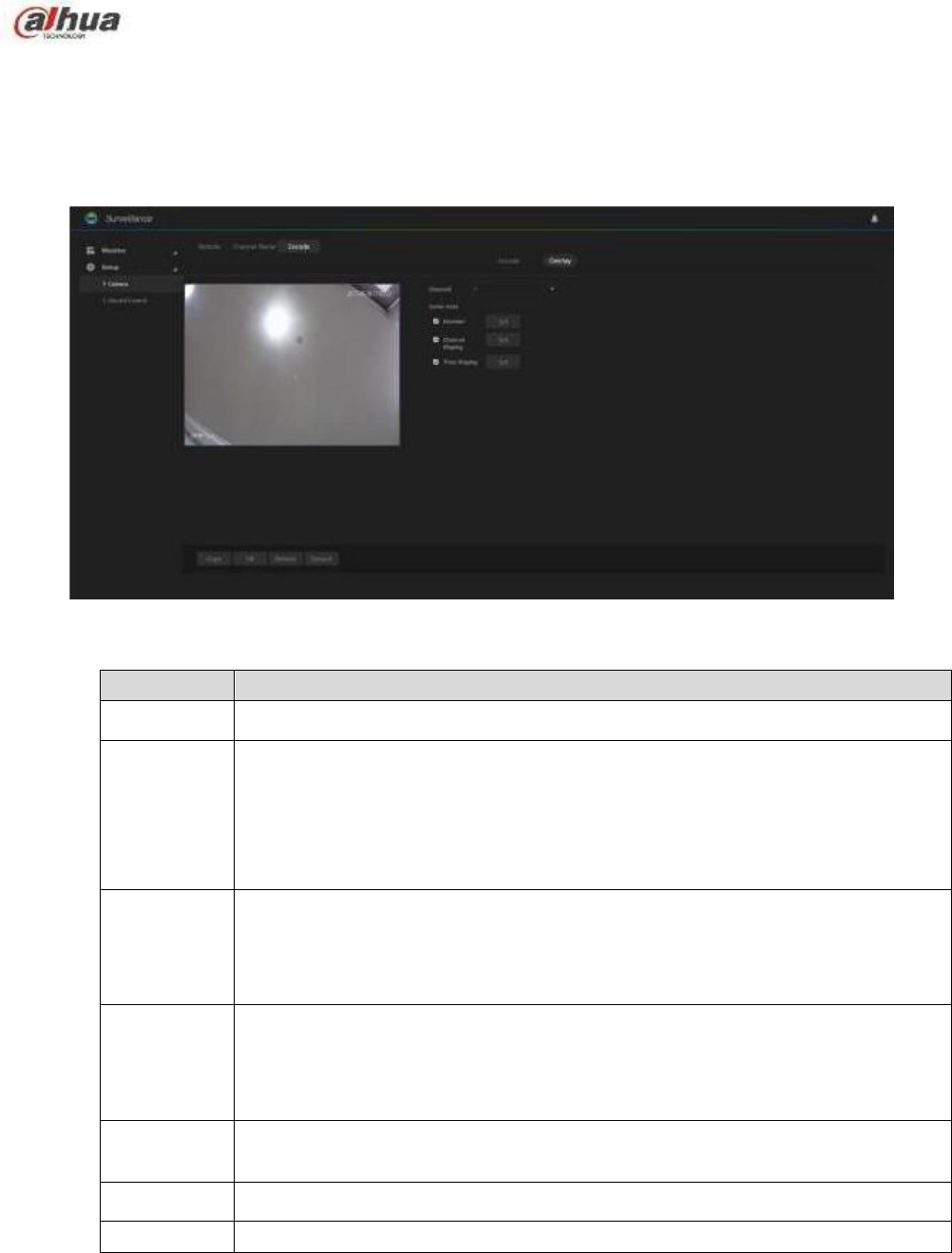
Name
Function
Channel
Please select a channel from the dropdown list.
Cover-area
It is to set privacy mask zone in the monitor video. The user cannot view the
cover area.
Note
Each channel max supports 4 privacy mask zones.
Time Title
Check the box to enable this function. Click the Setup button and then input
time. Drag the course title to the proper position and then click OK.
Click Save button, device can display time on the real-time video and playback
video.
Channel
Title
Check the box to enable this function. Click the Setup button and then input a
channel name. Drag the channel title to the proper position and then click OK.
Click Save button, device can display channel name on the real-time video and
playback video.
Copy
After set one channel setup, click Copy to copy current channel setup to other
channel(s).
Refresh
Click to get the latest setup information.
Default
Click to restore default setup. Click OK to save default setup.
Steps:
Step 1
Step 2
On the surveillance interface, from Setup->Camera->Encode->Overlay.
Enter overlay interface. See Figure 2-23.
Figure 2-23
Click OK to save settings.
2.7.3 Video
It is to view the real-time video , and playback video record.
2.7.3.1 Real-time Preview
On Monitor interface, from Monitor->Playback, enter preview interface. See Figure 2-24.
29
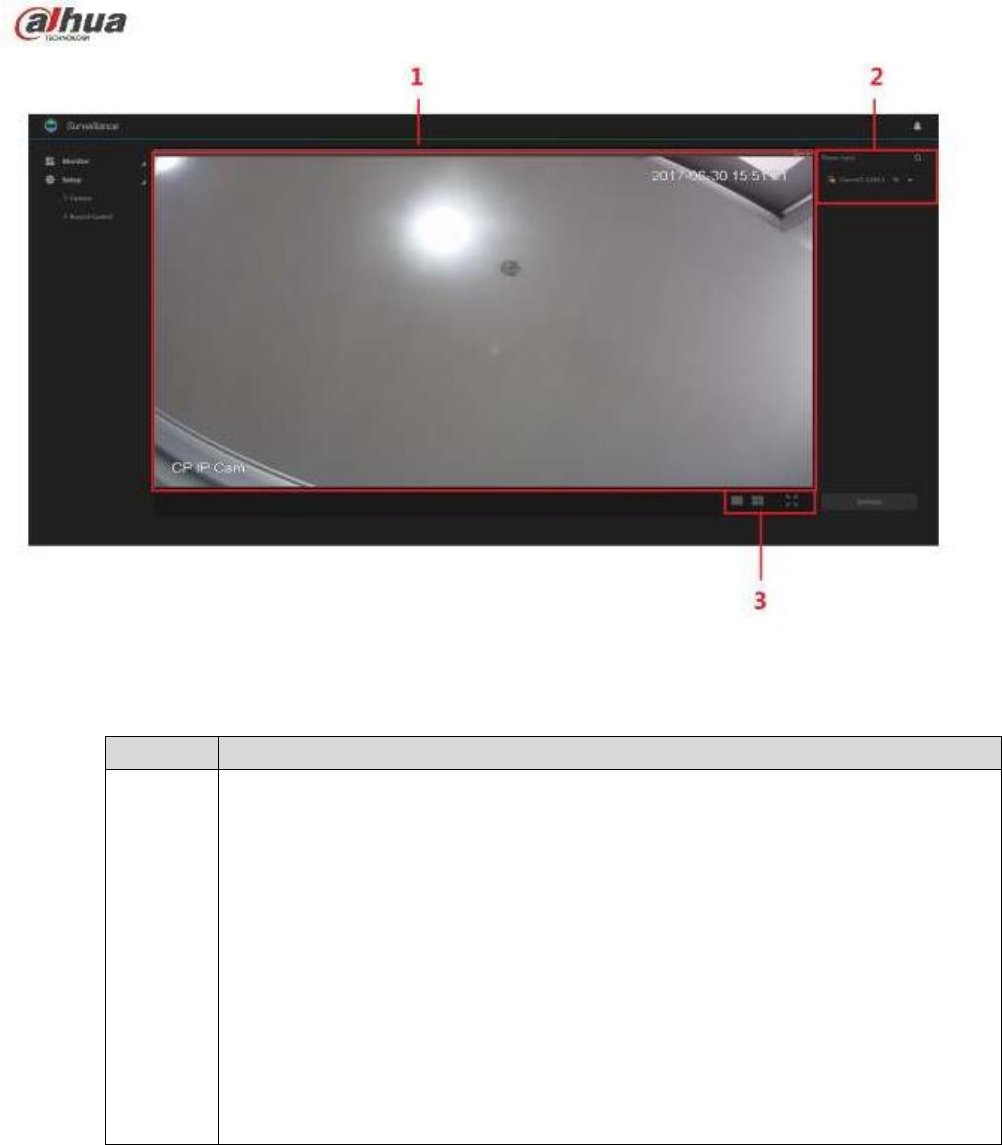
SN
Note
1
Real-time playback window. Click the online device on the channel list to view the
real-time video.
Click the dropdown menu of the remote device, it is to enable/disable main
stream/sub stream.
During the real-time monitor process, there are three buttons at the top right
corner: digital zoom, audio and close.
: Click it, and then left click mouse to select a zone. It is to zoom in the
specified zone. Click the icon again or right click mouse to restore original
state.
:Click to enable/disable audio. There is no audio during real-time
preview mode, if the audio function is null here.
: Click to close the video monitor on current window.
Figure 2-24
Please refer to the following table for detailed information.
30
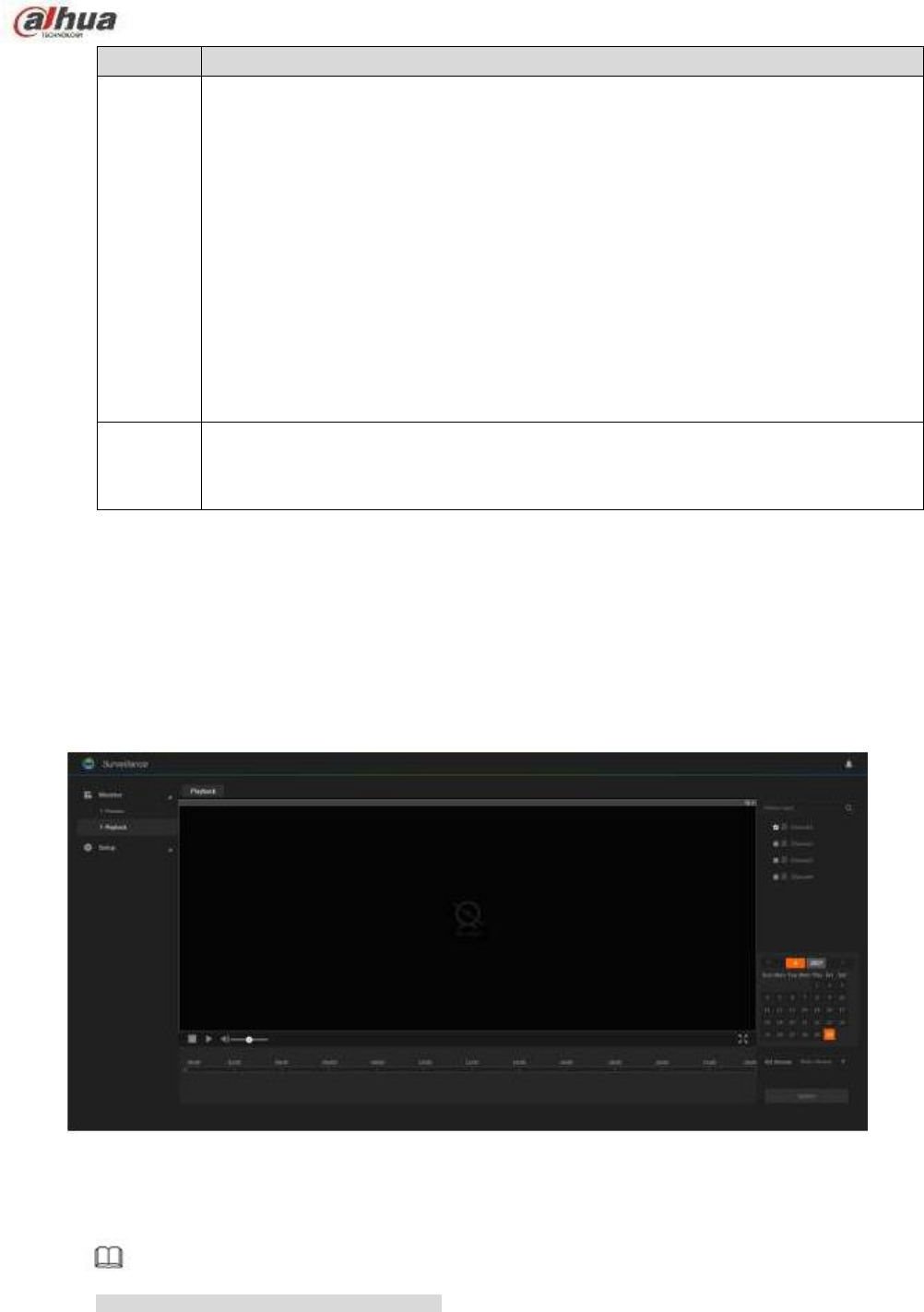
SN
Note
2
Monitor channel list. Click the dropdown menu of the channel name to select main
stream/sub stream to play.
: Remote device is offline.
: Remote device is online.
: The remote device is playing real-time video.
Note
Make sure the remote device supports sub stream and has enable sub stream
function.
3
Switch real-time monitor window amount. System supports 1/4-window.
Click to go to full-screen preview interface. Click Ese to exit.
2.7.3.2 Playback
Steps:
Step 1
Step 2
Step 3
On Monitor interface, from Monitor->Playback.
Enter playback interface. See Figure 2-25.
Figure 2-25
Select channel number from the channel list.
Note
System supports 1-channel playback only.
Select date and bit stream type.
Click the date, the time bar displays current date record information.
31
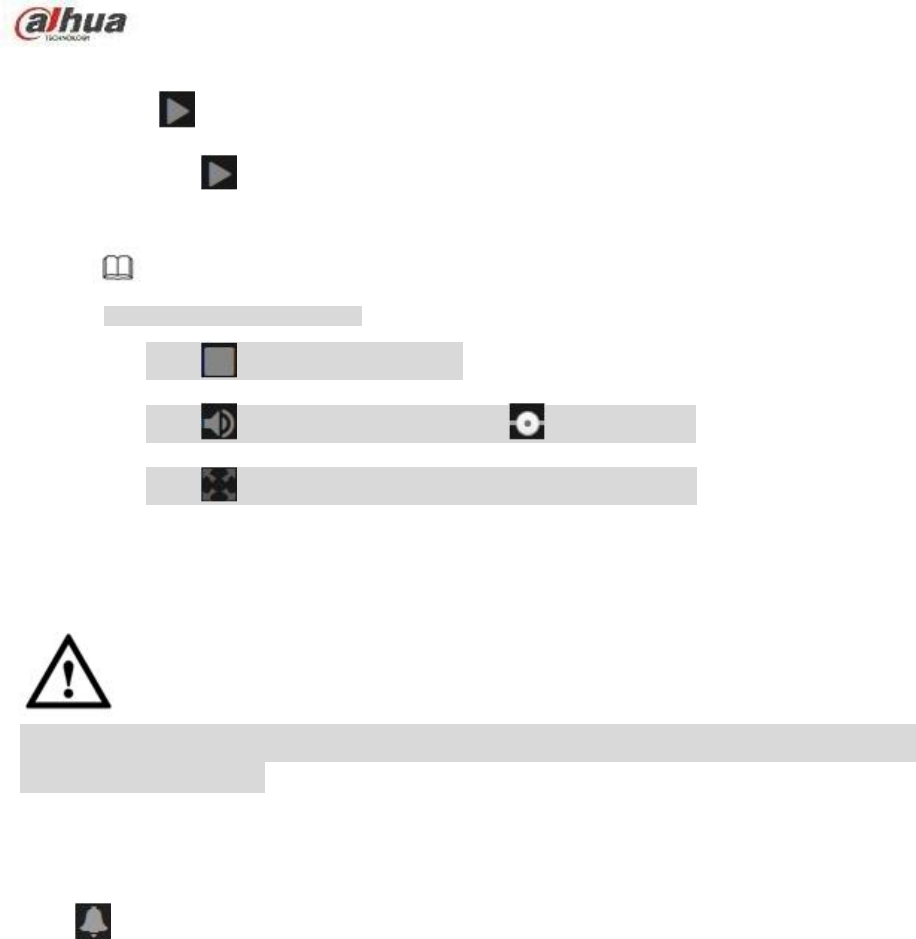
Bit stream includes main stream/sub stream.
Step 4
Click
or click any position on the time bar, it is to playback the record file.
Click
, system begins playing from the beginning time of the record time.
Click any position in the time bar, system begins playing from the selected time.
Note
During the playback process:
Click
to stop playing record.
Click
to mute the audio. Drag the
to set volume.
Click
to go to full-screen. Click Esc to exit full-screen.
2.7.4 Alarm
It is to view alarm log occurred time, channel number, alarm type and process state.
CAUTION
The alarm information in the following interface is for current login user only. After login again, system
clears all alarm information.
Steps:
Click
, enter alarm interface. See Figure 2-26.
Set alarm search criteria to view the detailed information.
32
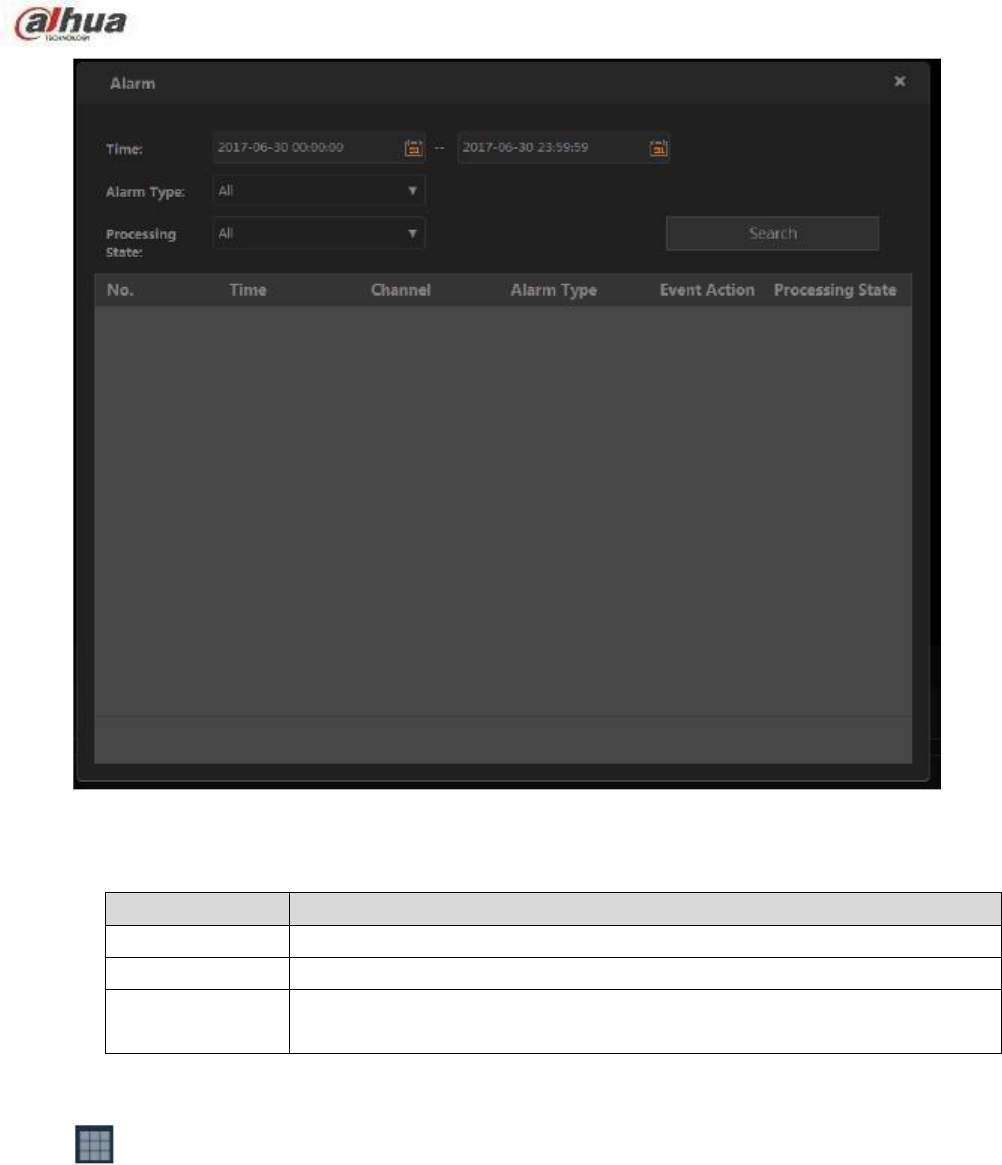
Name
Function
Time
Set alarm log search period.
Alarm type
Set alarm type.
Process state
Set alarm process state. It includes:all,pending, fixed, false alarm and
ignored.
Figure 2-26
Please refer to the following table for detailed information.
2.8 Version
Click
in the main interface, enter version interface. See Figure 2-27.
33
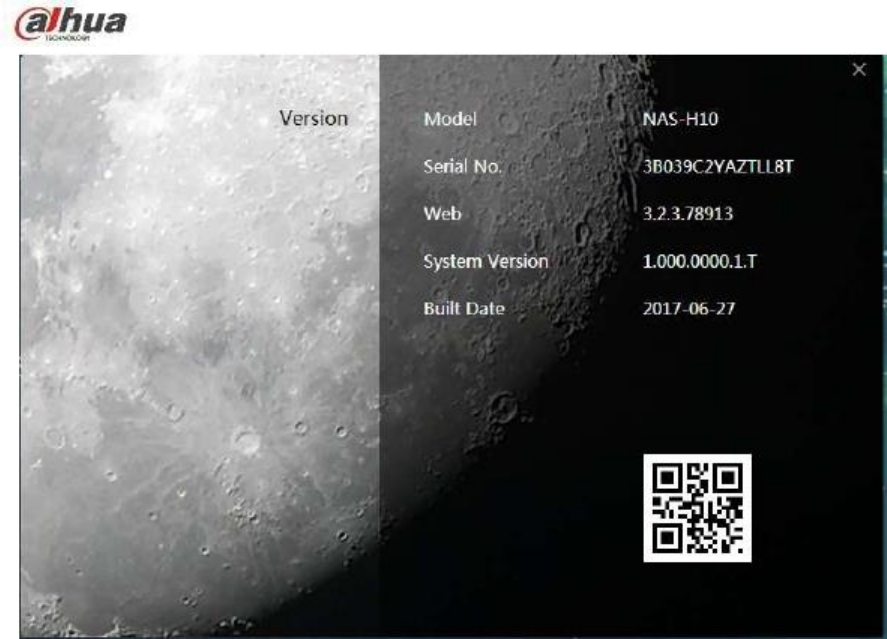
Figure 2-27
34

3 ConfigTool
Please use ConfigTool to search, access and set the NAS device. Refer to ConfigTool User’s manual for
detailed information.
35

Name
Function
OS
OS
Google CTS Certified Android5.1OS
CPU
Quard 64-bit high performance ARM CortexA53, max
2.0GHz
Memory
2GB DDR3
Flash
4GB eMMC
HDD
2.5-inch HDD, support 1T/2T and more.
Audio/Video
Audio Decode
DTS HD, DTS M6, Dolby Digital Plus
Output
Resolution
Max 4K(3840×2160)output, support HDR
Video Decode
H.265 4K2K@60f/s, H.264 4K2K@30f/s, VP9 4K2K@60f/s,
MPEG1/2/4、VC-1 1920&1080P@60f/s
Network
WIFI
IEEE 802.11b/g/n, band 2.4G
Port
Power port
1 power input port, 12V/1.5A power
Network Port
1 100/1000Mbps self-adaptive Ethernet port
HDMI Port
1 HDMI port
USB Port
1 USB2.0 port, 1 USB3.0 port
Audio Output
Port
1 3.5mm audio output port
SD Card Port
1 Micro SD card port. Max 128G expansion storage space.
Button
RESET button
1 reset button. Press for at least 8 seconds to restore factory
default setup.
Indicator
Light
Power
Indicator
Light
1 power indicator light
HDD Indicator
Light
1 HDD indicator light
Other
Working
Temperature
-10℃~40℃
Working
Humidity
10%~90%
Lightening
Proof
IEC61000-4-5 compliance,Level 2
Anti-Static
GB9254 Class B
Shock-Proof
1 meter shock proof
Dimensions
(L×W×H)
229.8mm×158.9mm×32.1mm
Weight
550g(With HDD)
4 Appendix-Specifications
36

Download
Mode
Note
Magnet URI
Download
Magnet URI is a special link. It is different from the tradition download based
on the file position or the general link. The Magnet URI downloads the Hash
results from contents of different files and generates one pure digital
fingerprint. It uses the fingerprint to identify the file. The fingerprint can be
generated from anyone from any file. So the magnet URI download does not
need the support from any organizations or party and has high recognition
rate. It is easy to spread.
The standard magnet-uri download format is similar to
magnet:?xt=urn:btih:ESTZ24OIGMS5VGYTUV73E3Y5P7CH4XMG。
HTTP
Download
HTTP is so called Hyper Text Transportation Protocol. It is the underlying
protocol used by the World Wide Web and this protocol defines how messages
are formatted and transmitted, and what actions Web
servers and browsers should take in response to various commands.
HTTP download format is similar to http://www.aaa.com/a.jpg。
HTTPS
Download
HTTPS is so called Hyper Text Transportation Protocol over Secure Socket
Layer. It is a communications protocol for secure communication over a computer
network which is widely used on the Internet.
HTTPS download format is similar to https://www.aaa.com/a.jpg.
FTP
Download
FTP is so called File Transportation Protocol. It is a standard network
protocol used for the transfer of computer filesbetween a client and server on
a computer network. Its download theroy is similar to the HTTP, but it needs a
user name and password to login the FTP server (User can use the general
account or do not need to input the user name or password if the FTP server
supports anonimous login. )
FTP download format is similar to ftp://ftp.ftpserver.com/ 或
ftp://192.168.12.34.
FTPS
Download
FTPS is so called File Transportation Protocol over Secure Socket Layer. It
uses SSl protocol to transmit encrypted FTP data. It is a FTP method for
secure communication.
FTPS download format is similar to ftps://ftp.ftpserver.com/ or
ftps://192.168.12.34.
5 Appendix-Download Modes
37

Note
•
•
•
•
•
This manual for reference only. Slight difference may be found in the user interface.
All the designs and software here are subject to change without prior written notice.
All trademarks and registered trademarks are the properties of their respective owners.
If there is any uncertainty or controversy, please refer to the final explanation of us.
Please visit our website or contact your local service engineer for more information.
38